If they hadn’t shown up when I was looking, I never would have known they existed. That got me thinking about how crucial search visibility really is for auto businesses.
This article isn’t just my take on automotive SEO. It’s been reviewed, enriched, and inspired by seven experts with hands-on experience in this niche. Their insights helped me keep this guide grounded in real-world experience.
- Michelle Tansey, Founder, Red Queen Marketing
- Edward Bate, SEO Consultant, edwardbate.com
- Despina Gavoyannins, Senior SEO, Ahrefs
- José Luis Rivolta, SEO Director, Refindable
- Daniel Lofaso, CEO and Founder, Digital Elevator
- Harpreet Munjal, founder of LoudGrowth
- Parker Evensen, CEO & Founder, Honest Digital
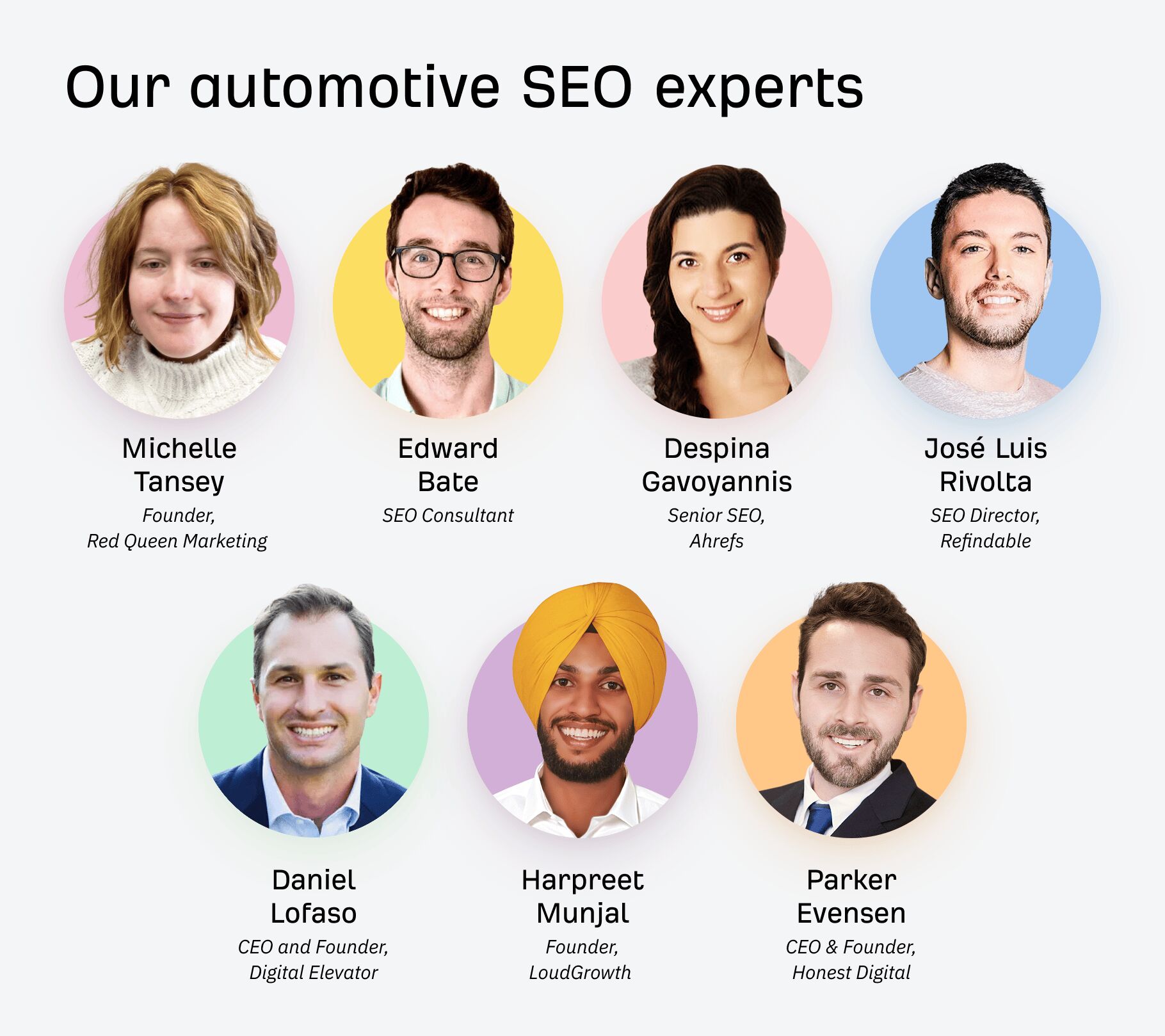
The automotive industry covers a lot of ground: dealerships, repair shops, auto parts sellers, manufacturers, and more. While I’ve focused on SEO tactics that apply universally across most automotive businesses, I’ll call out specific strategies where needed. If you’re looking for in-depth guidance tailored to your business type, I’ll point you to more focused resources along the way.
Think of automotive SEO as making sure you show up when people search for cars or auto services online. It’s different from regular SEO because car shopping is… well, it’s pretty unique.
Here’s what makes it special:
- People search locally first. When someone needs a car or repair work, they’re usually thinking “near me” from the get-go. They want something close to home.
- Your inventory never stops changing. Unlike a restaurant that keeps the same menu for months, you’re constantly getting new cars and selling others, and your website needs to keep up with that.
- You’re really running multiple businesses. Sales, service, parts, financing–each department attracts different customers who search in different ways.
- Trust is everything. Nobody impulse-buys a $30,000 car. People need to feel confident about you before they’ll even visit your lot.
- Franchising is a double-edged sword. If you’re a franchise dealer, the manufacturer likely imposes strict rules on what you can and can’t do with your website and marketing. That can limit your ability to optimize freely. But on the flip side, being able to use an automaker’s brand in your business name, domain, and on-page content can give you a significant SEO advantage—especially for branded searches like “used toyota”.
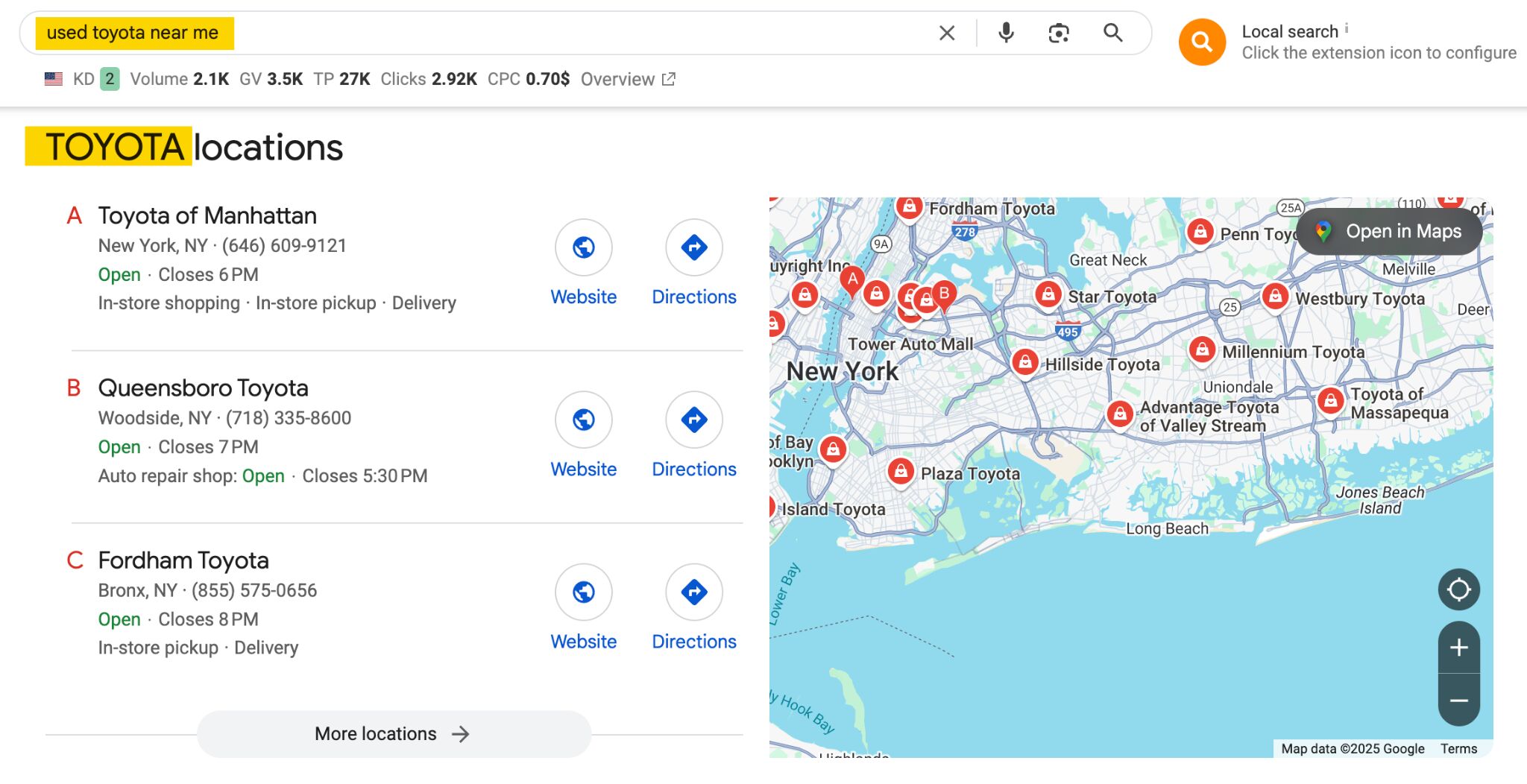
Every page you optimize adds to your ability to attract customers. The results work for you 24/7, and build on each other over time. But that’s not all:
- You catch people wherever they are in their journey. Some folks are just starting to research cars, while others are ready to buy tomorrow. Good SEO content lets you connect with all of them by providing helpful information that naturally showcases what you know.
- You steal customers from competitors. It’s that simple. If you’re ranking #1 for “used cars in Dallas” and your competitor is #8, guess who’s getting that customer?
- It pays for itself over time. SEO takes work upfront, but unlike paid ads that cost you every month, good content can keep bringing in customers for years. That’s huge in the car business, where people research for weeks before buying and need ongoing service.
Local SEO gets you into Google Maps and those local results that show up before the regular website listings. Even if searchers don’t include location names in their searches, Google might still interpret them as local search intent and prioritize the best results in the nearby area.
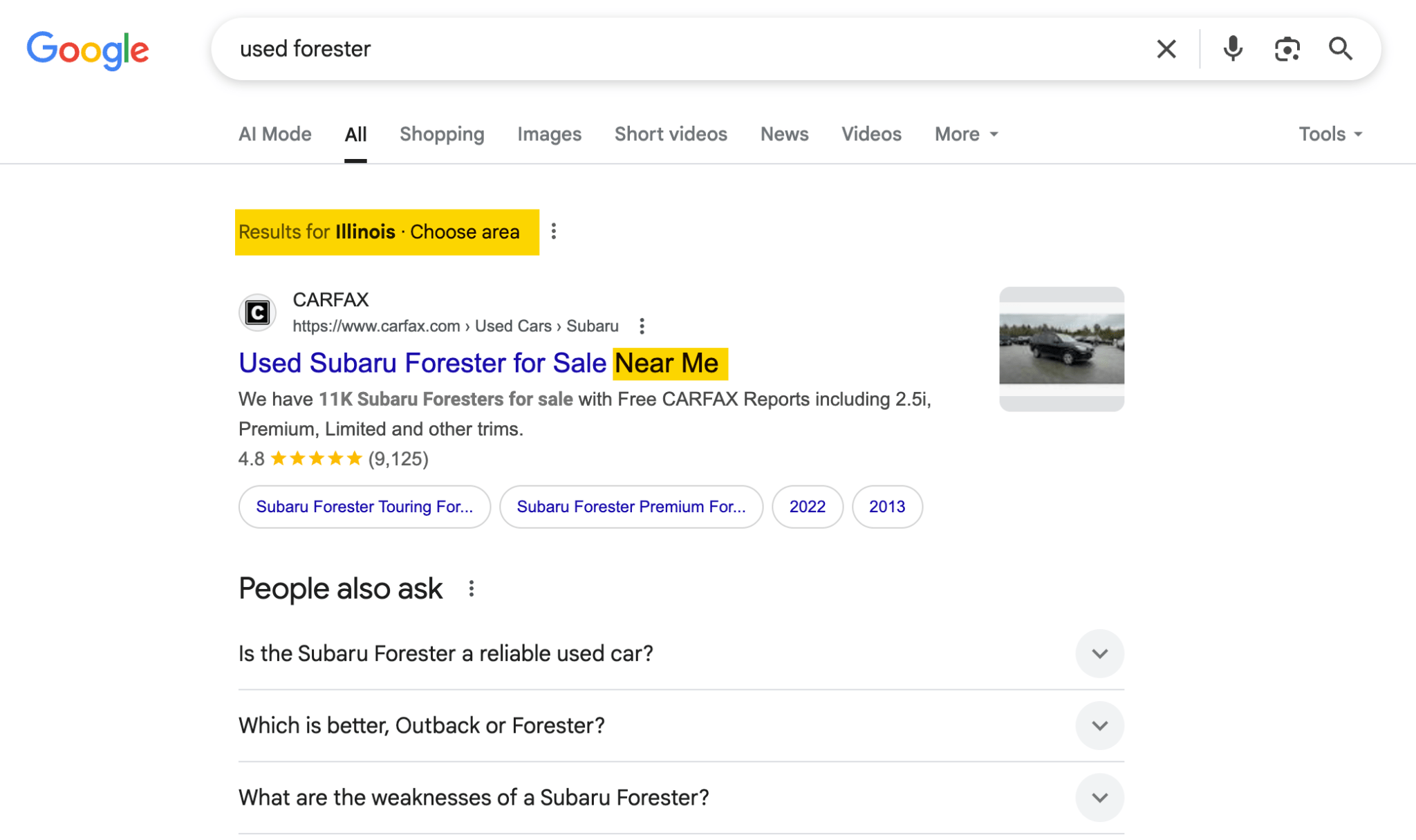
Give each location its own page and Google Business Profile
Google sees each of your locations as its own separate business, so each one needs to be optimized individually. That means creating a dedicated page for every location, complete with unique content, local reviews, contact details, and photos of that specific spot and team.
Take Christian Brothers Automotive, for example. They have dozens of locations, each with its own optimized landing page and Google Business Profile.

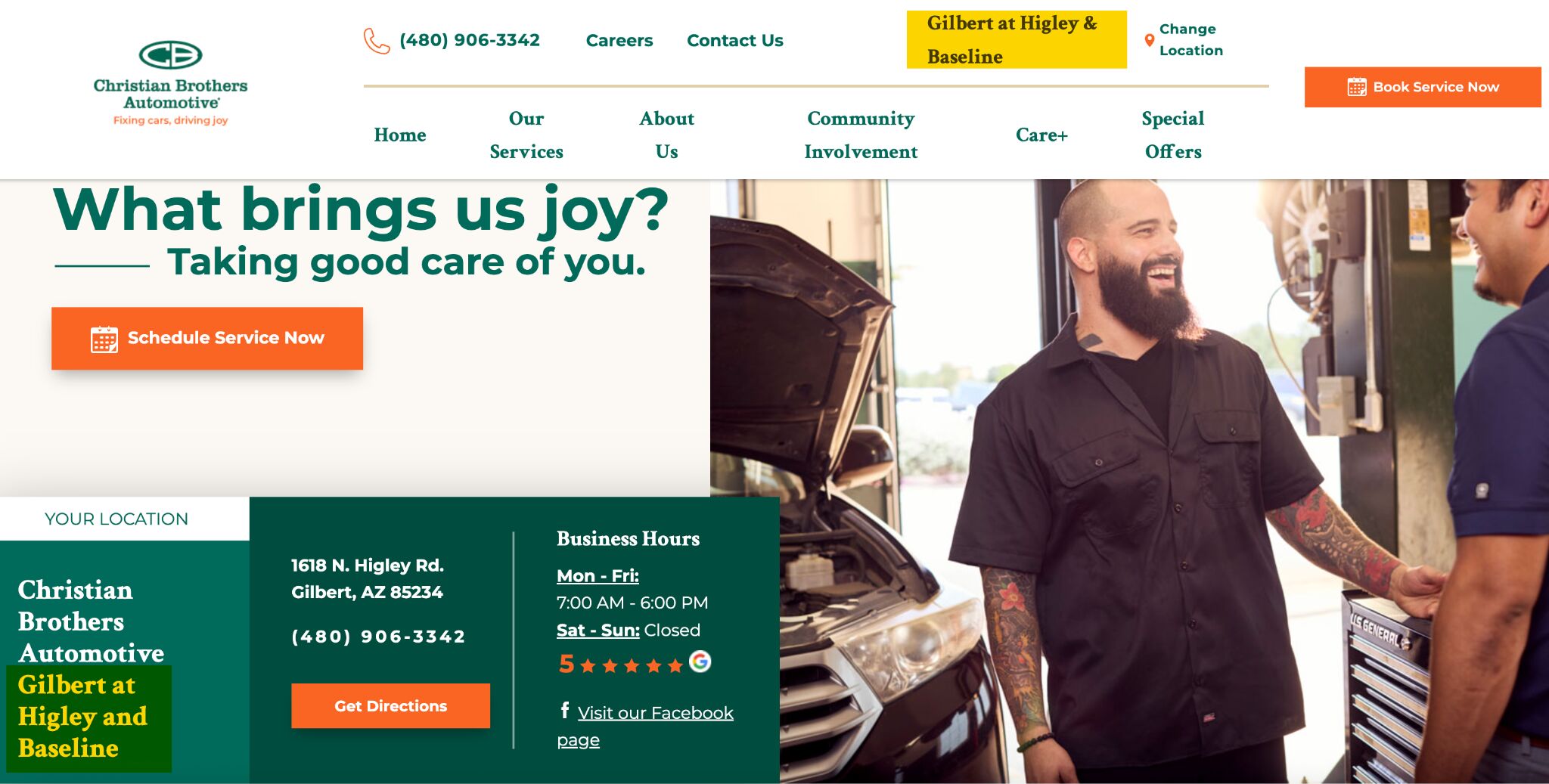
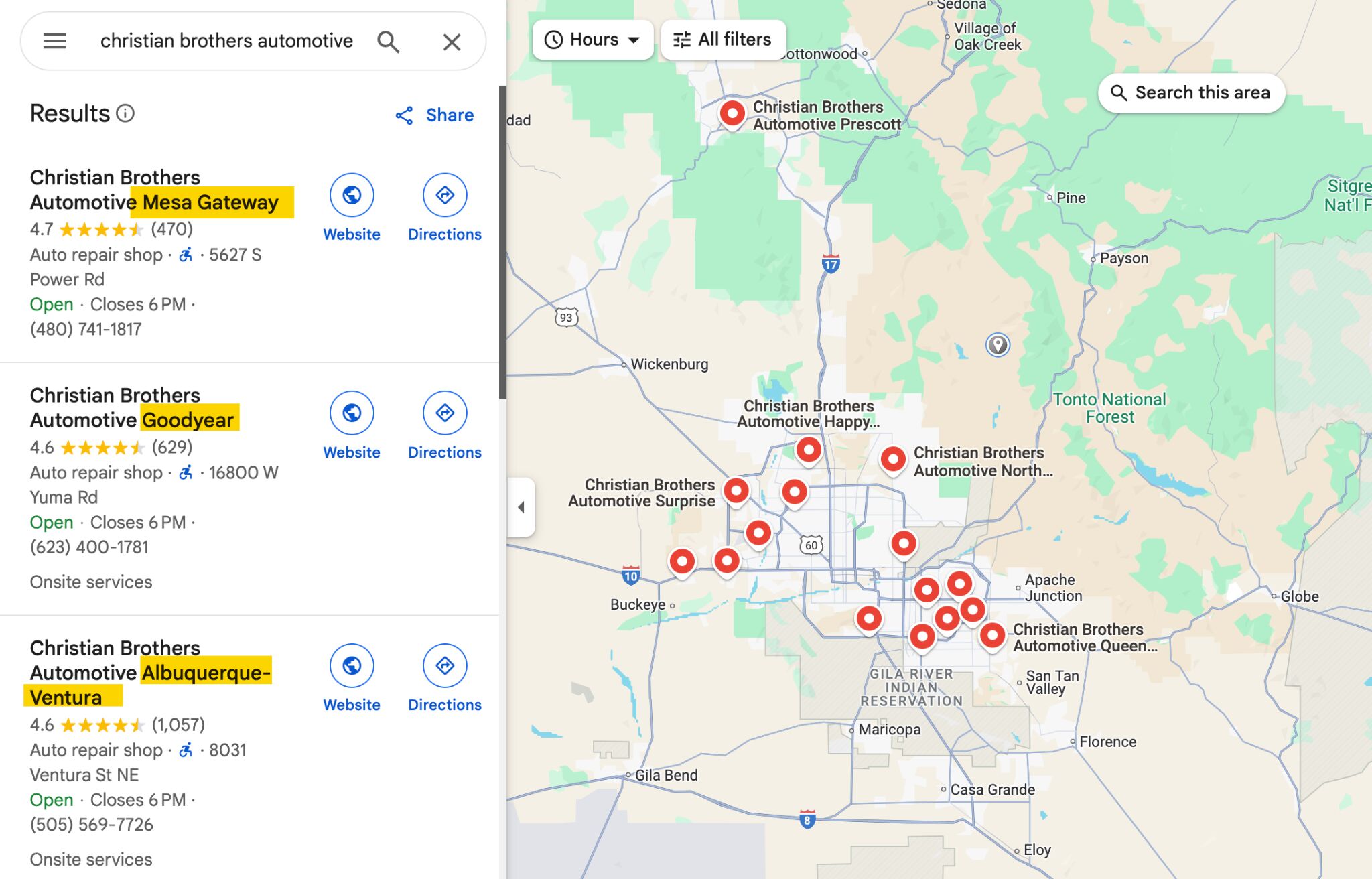
Get listed in directories and listing aggregators
Get listed in automotive directories like Edmunds and Cars.com, as well as general local directories like Yellow Pages and your Chamber of Commerce. Keep your branding and services consistent across these listings.
This has a direct and indirect benefit.
Direct benefit: referral traffic and lead generation. Many of these directories rank highly in search results themselves and are used by shoppers during the research phase. Being featured there can send highly qualified traffic your way.
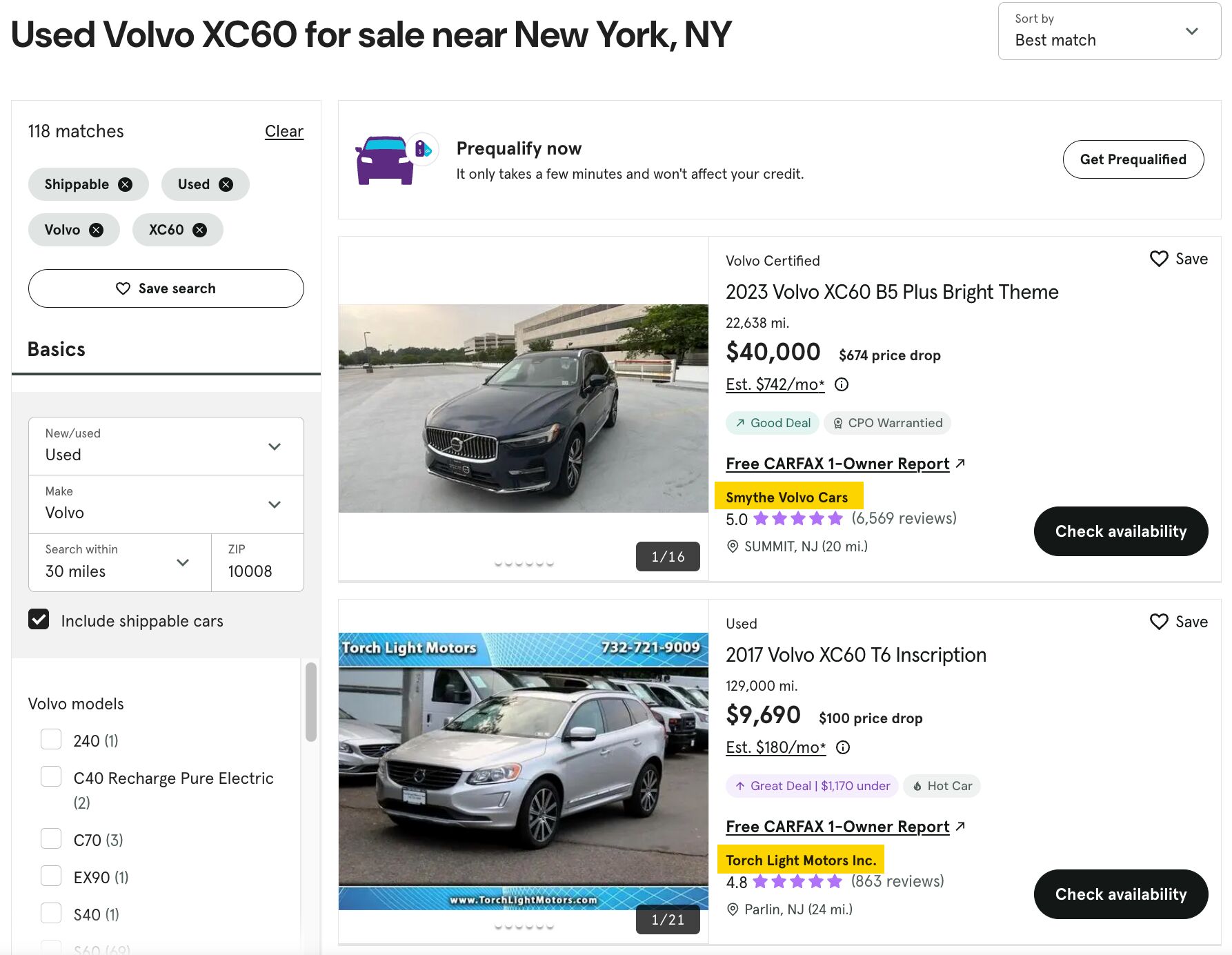
Indirect benefit: stronger local SEO signals. Google and other search engines rely on data from third-party sites to validate your business’s legitimacy and location (the so-called NAP citations). When your business details are accurate and consistent across multiple reputable sources, it strengthens your local ranking signals, especially in map pack and “near me” searches.
Stay active on your Google Business profile
Regular updates to your Google Business Profile (new photos, responding to reviews, posting announcements) show Google and customers that you’re actively managing your business.
When the competition is tough, even small things, like regularly updating your Google Business Profile or responding to reviews, can be what sets you apart and helps customers choose you over others.
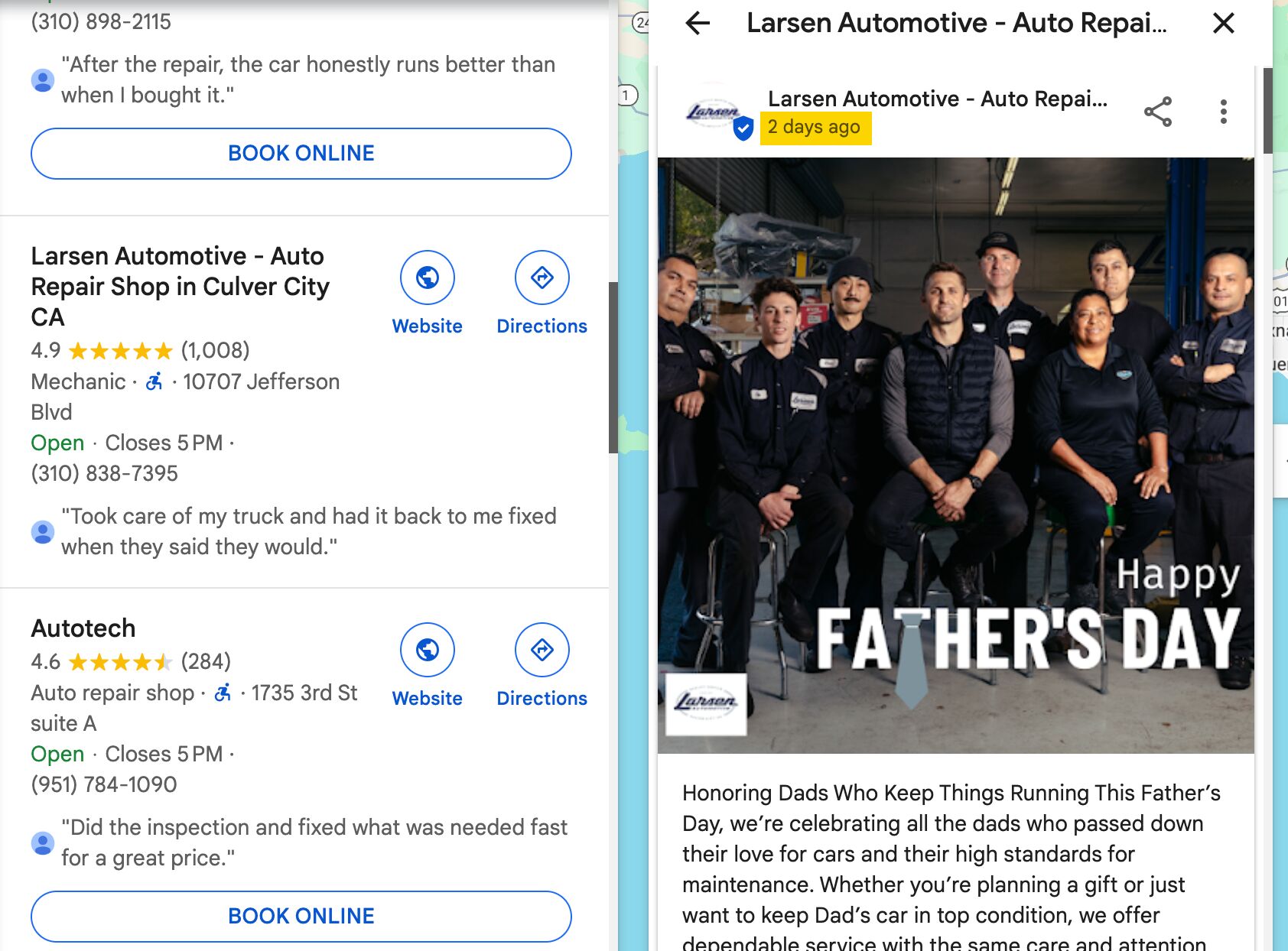
Set up inventory integration in Google Business Profile
If you’re a dealership, don’t miss out on Google’s free Vehicle Listings integration. This feature lets you push your current inventory directly into Google Business Profile, making your cars eligible to show up in local map results, the Shopping tab, and even within the “Cars for Sale” section on Google Search.
It’s one of the few industry-specific perks Google offers, and it’s completely free. Here’s the official guide you need to set this up. 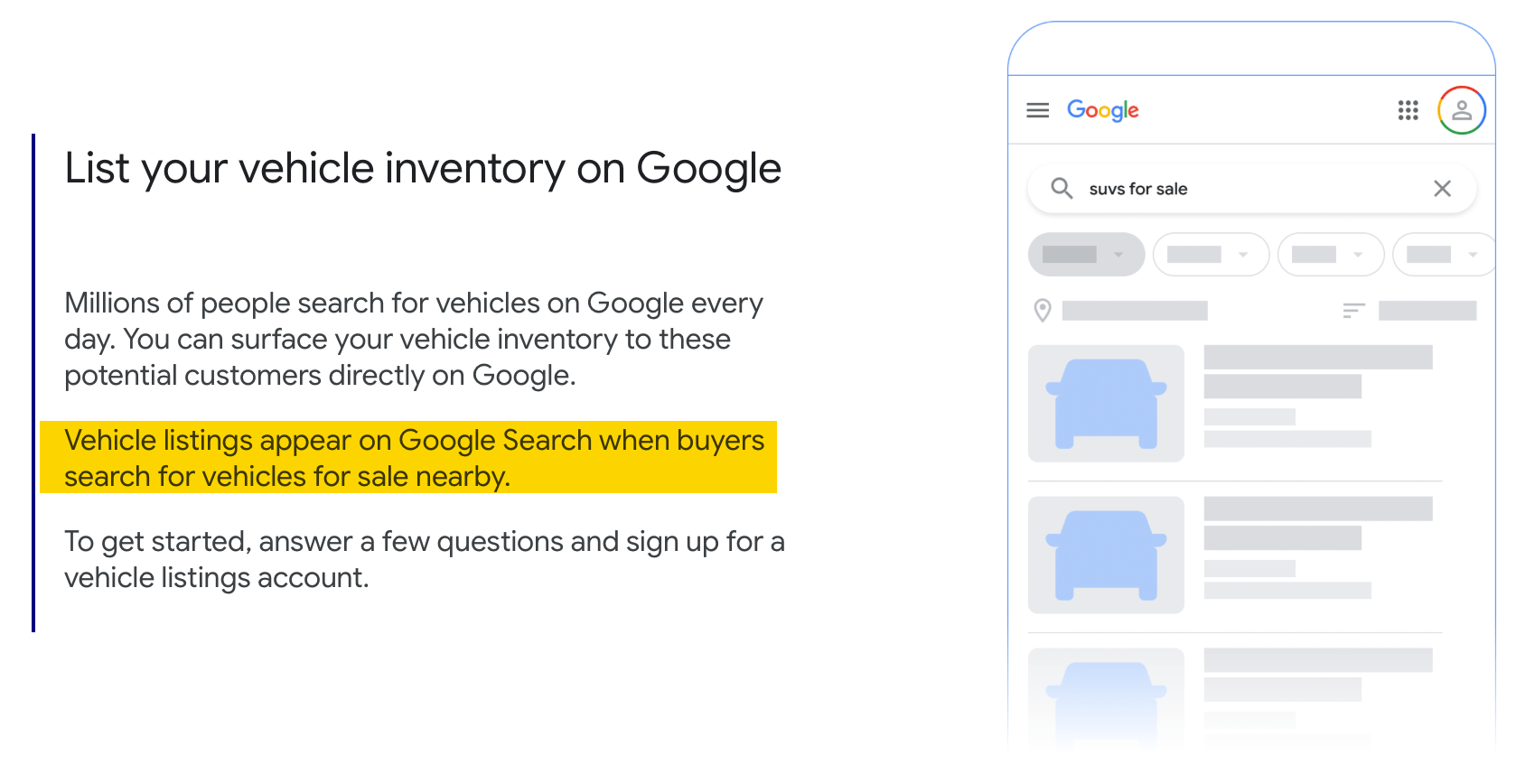
In the automotive world, trust is a dealbreaker. Shoppers want to know they’re dealing with a business that’s honest, responsive, and delivers on its promises. And guess what, Google always looks at online reviews to determine the best local search result (see prominence).
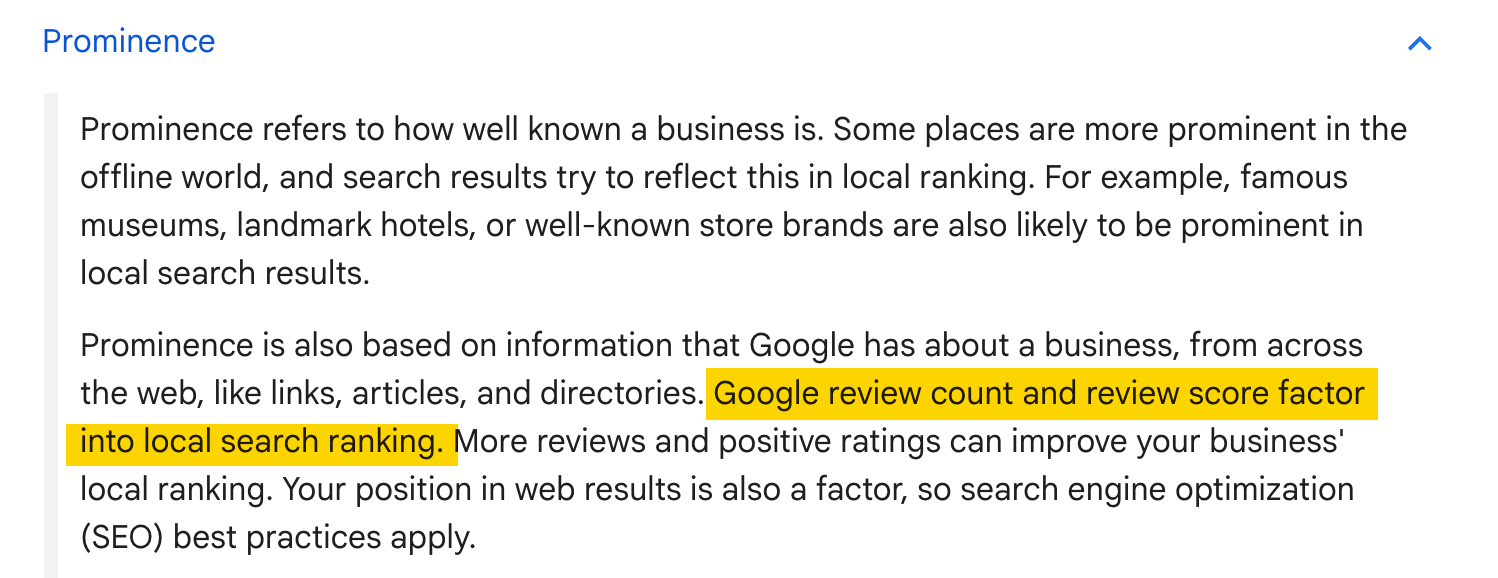
So here’s what you can do:
- Ask for reviews actively. Send review links via text, ask in person, or include it on thank-you pages.
- Respond to every single review. This shows you’re listening and builds trust.
- Monitor everything. Use tools like Birdeye to track reviews across all major platforms.
- Show off your good reviews. Social proof matters—highlight those stars!
- Go beyond reviews. Mention awards, certifications, sales stats, and success stories.
Keyword targeting connects your website with people who are actively searching for what you offer. It’s how you show up for a buyer typing in “used Honda Civic near me” instead of disappearing behind a wall of irrelevant traffic.
I’m going to walk you through the types of keywords (with examples) you’ll likely need to reach potential customers at every stage of their journey—from early research to purchase and beyond. Each keyword type plays a different role in your overall strategy.
But before we dive in, I want to show you how easily you can find your own keywords.
Start by opening Ahrefs’ Keywords Explorer, and ask the built-in AI to suggest keywords relevant to your business.
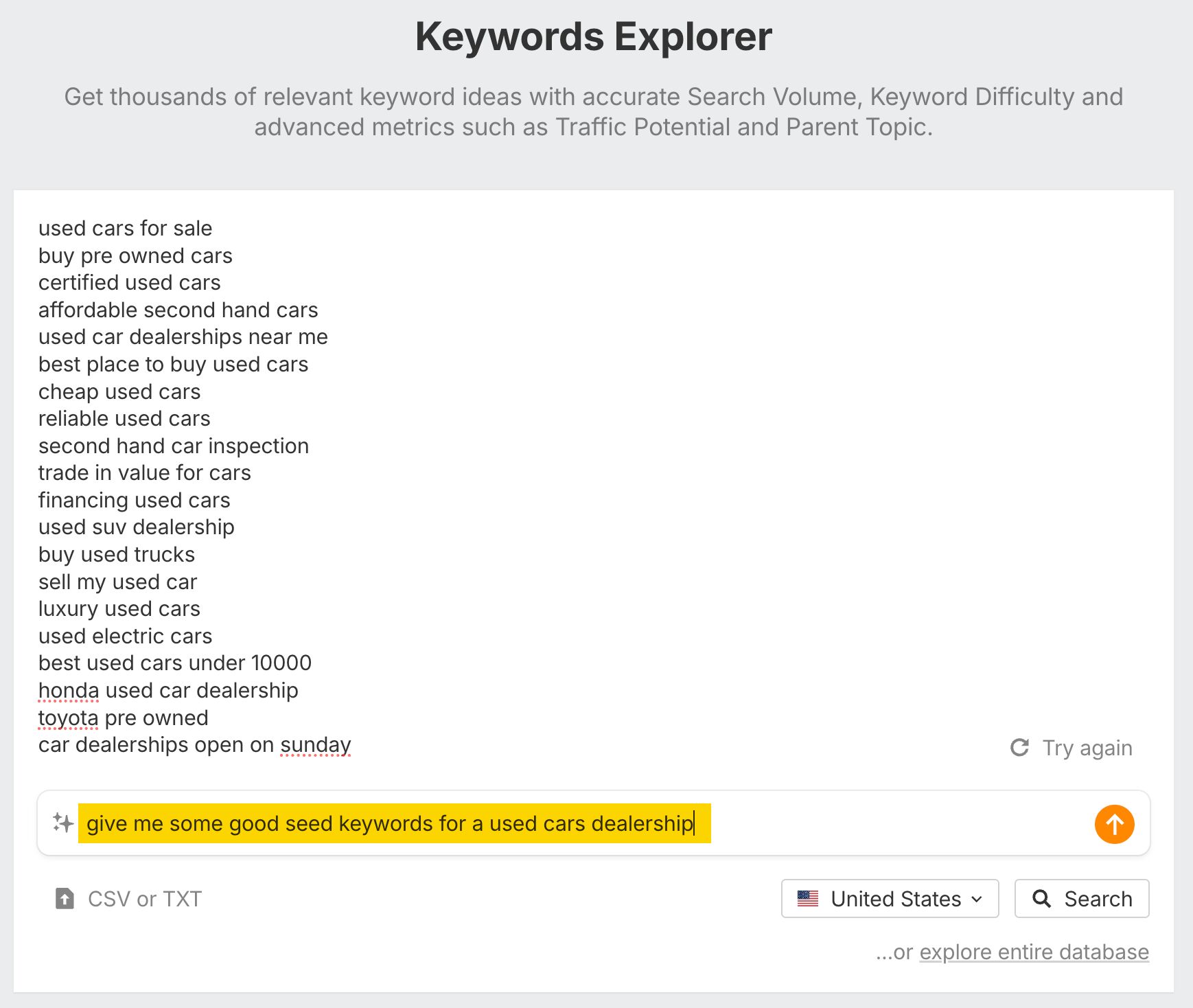
Then simply use one of the intent filters in the Matching terms report.
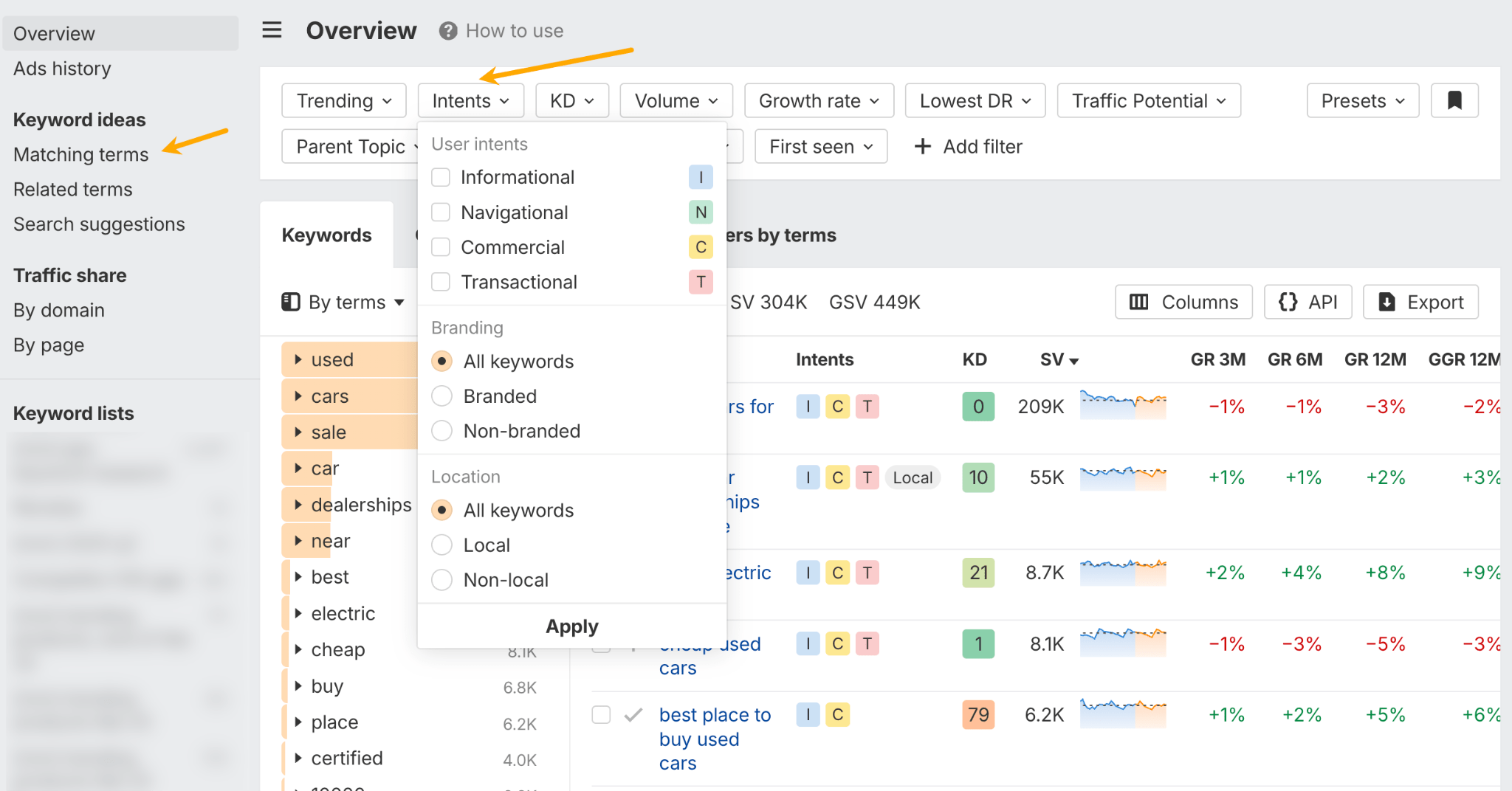
Commercial keywords
Commercial keywords capture people who are comparing options and making decisions. Ranking here helps you position your offerings as the better choice, even if they’re not yet ready to buy.
Examples:
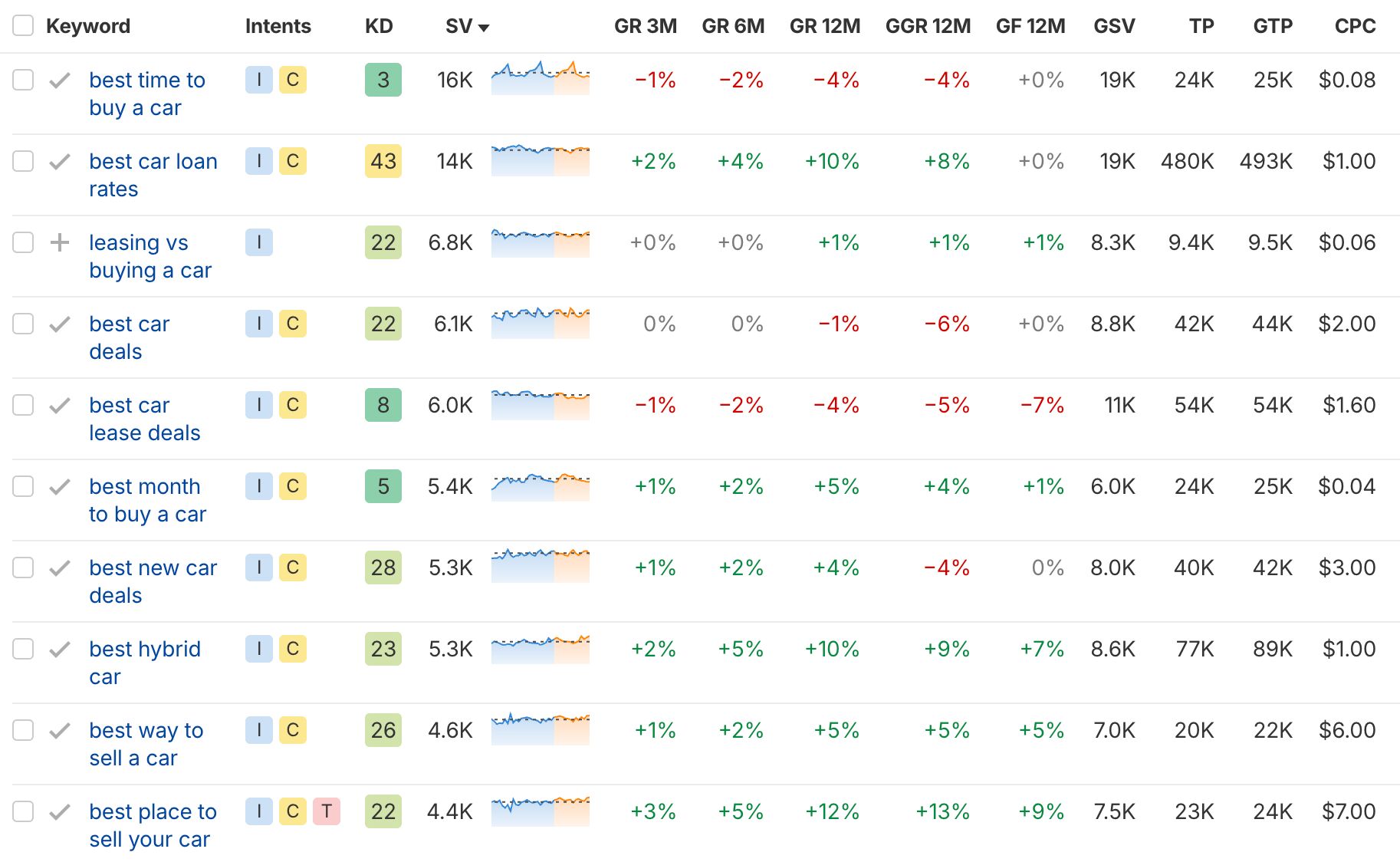
Dealerships usually have lower domain ratings than third-party lead providers, so sites like Cars.com dominate specials-related keywords like “2025 Toyota specials.” This is a problem because these keywords are crucial for capturing high-intent shoppers.
Parker Evensen recommends using a “hub-and-spoke” approach to combat this challenge. Build a comprehensive specials hub listing your main offers, then create model-specific specials pages that link back to it. This approach builds topical authority while giving you multiple chances to rank for valuable commercial keywords.
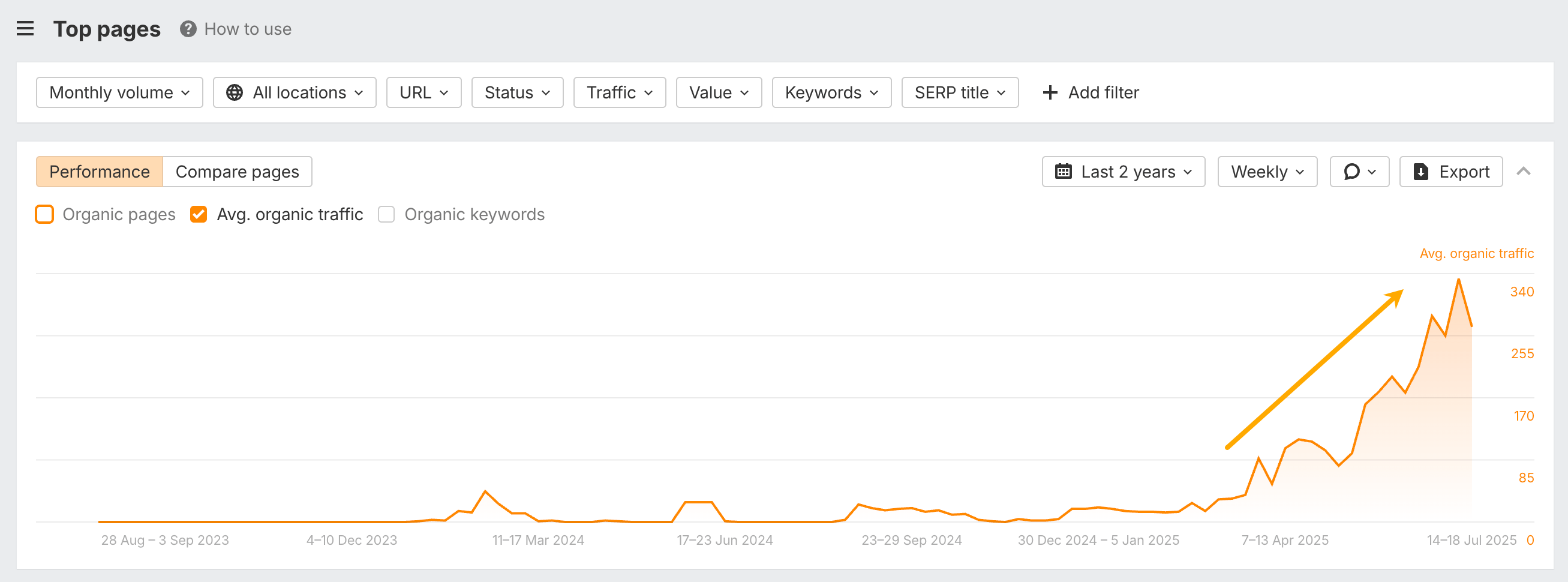
For example, a Toyota dealership would create a Toyota Specials Hub, then build dedicated pages for popular models like the Prius—including custom content, lifestyle images, review widgets, and schema markup.
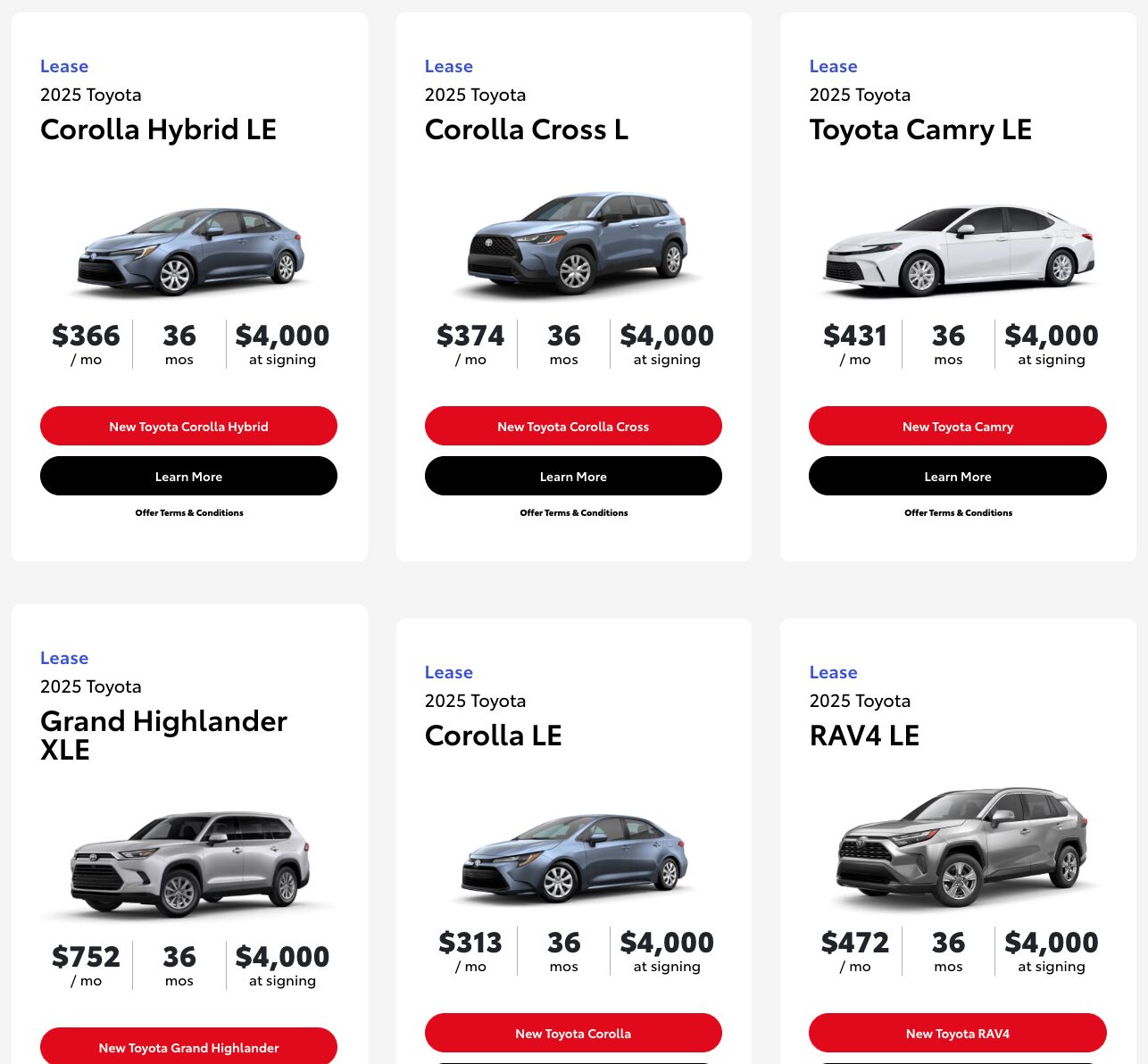
Hub page listing inventory available for leasing.
Transactional keywords
Transactional keywords are your conversion drivers. These are the high-intent searches from people ready to take action, whether that’s booking a test drive, scheduling a service, or calling your dealership.
Examples:
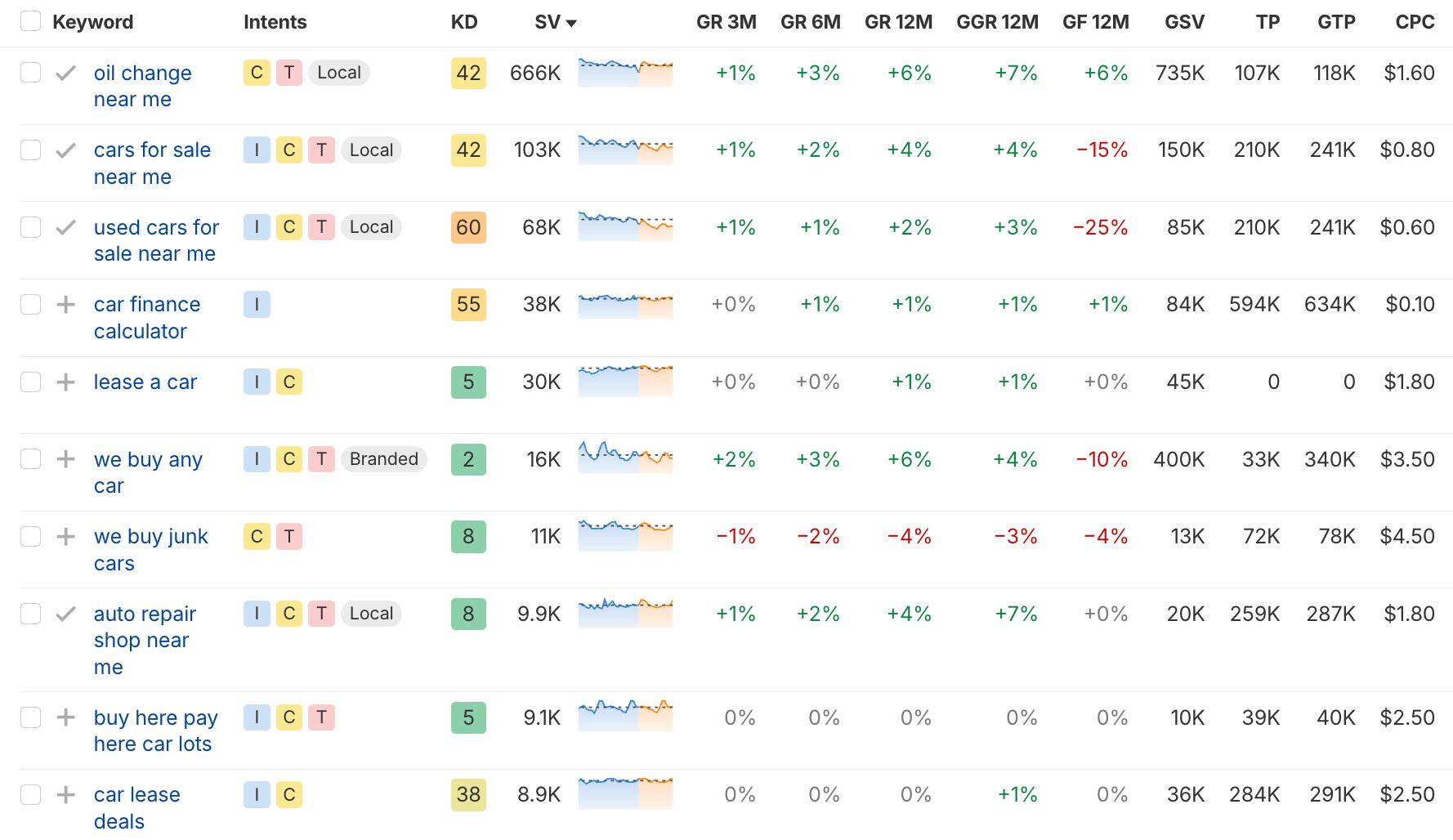
Informational keywords
Informational keywords attract early-stage searchers. They might not convert right away, but they build trust, brand awareness, and long-term visibility in your niche.
They’re also a smart way to expand your reach beyond your immediate area or build national awareness, since they usually address broader problems that apply everywhere. And because of that wide relevance, they have the potential to drive significant traffic to your site.

Examples:
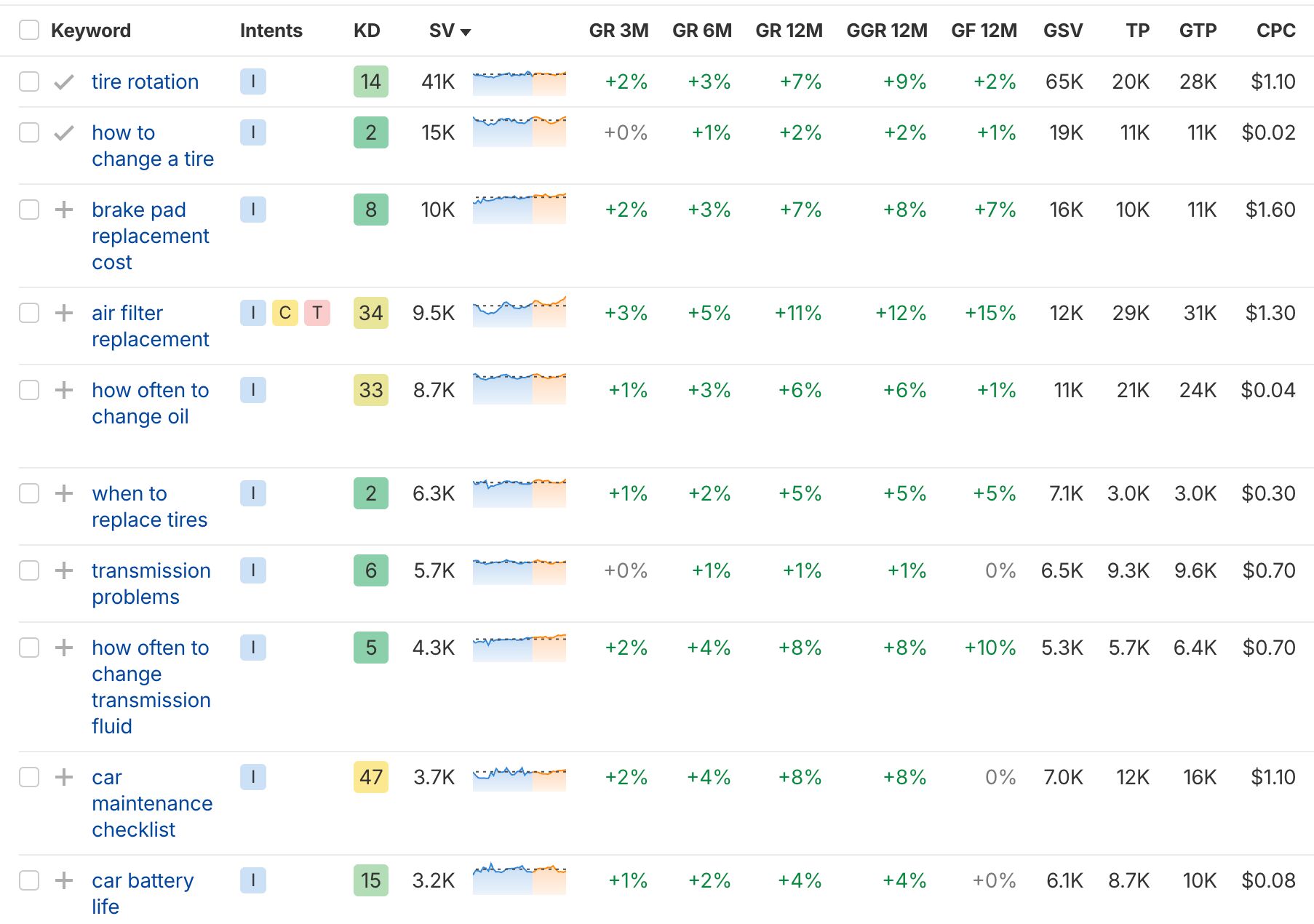
Local keywords
Local keywords are essential for showing up in map packs and nearby searches—especially important for dealers, service centers, and repair shops that serve specific geographic areas.
Besides using your keyword research tool, Michelle Tansey also suggested tapping into your team’s insights. Ask your staff what customers are often asking about or what tends to work well in your local area. Their firsthand experience can be a goldmine for content ideas.
Examples:
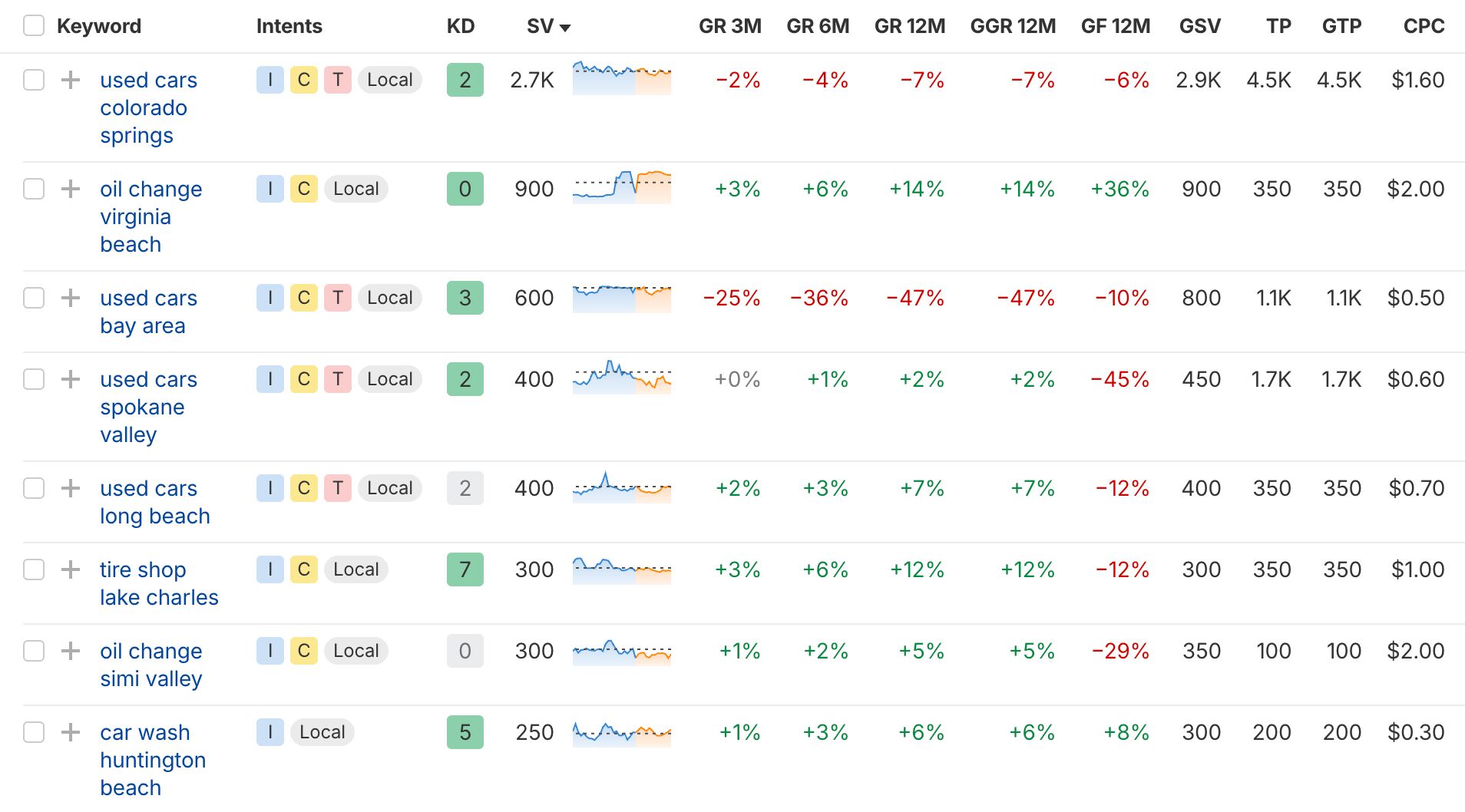
To prioritize which keywords to go after, balance these four factors:
- Search intent: Does the keyword match what you actually offer?
- Traffic potential: Will ranking for this keyword bring enough people to your site?
- Keyword difficulty: Can you realistically rank for it given your site’s current authority?
- Business potential: How likely is this keyword to drive real revenue for your business?
To win at automotive SEO, your site needs to support what customers are actually looking for, which depends on your business type. That said, most successful automotive sites tend to focus on these three functional areas:
- E-commerce style inventory pages. Show what you offer, whether that’s vehicles for sale, parts, or services.
- Service pages. Make it easy to book, buy, or inquire, depending on your offering.
- Location pages. Prove you’re local and legit, so customers know you’re nearby and trustworthy.
Each requires its own SEO strategy, and depending on your business model, you’ll emphasize some more than others.
Let’s break it down.
Inventory pages (ecommerce-style for vehicles and car parts)
These are the digital equivalent of your car lot. They power transactional searches like “used Mazda CX-5 under 20k.”
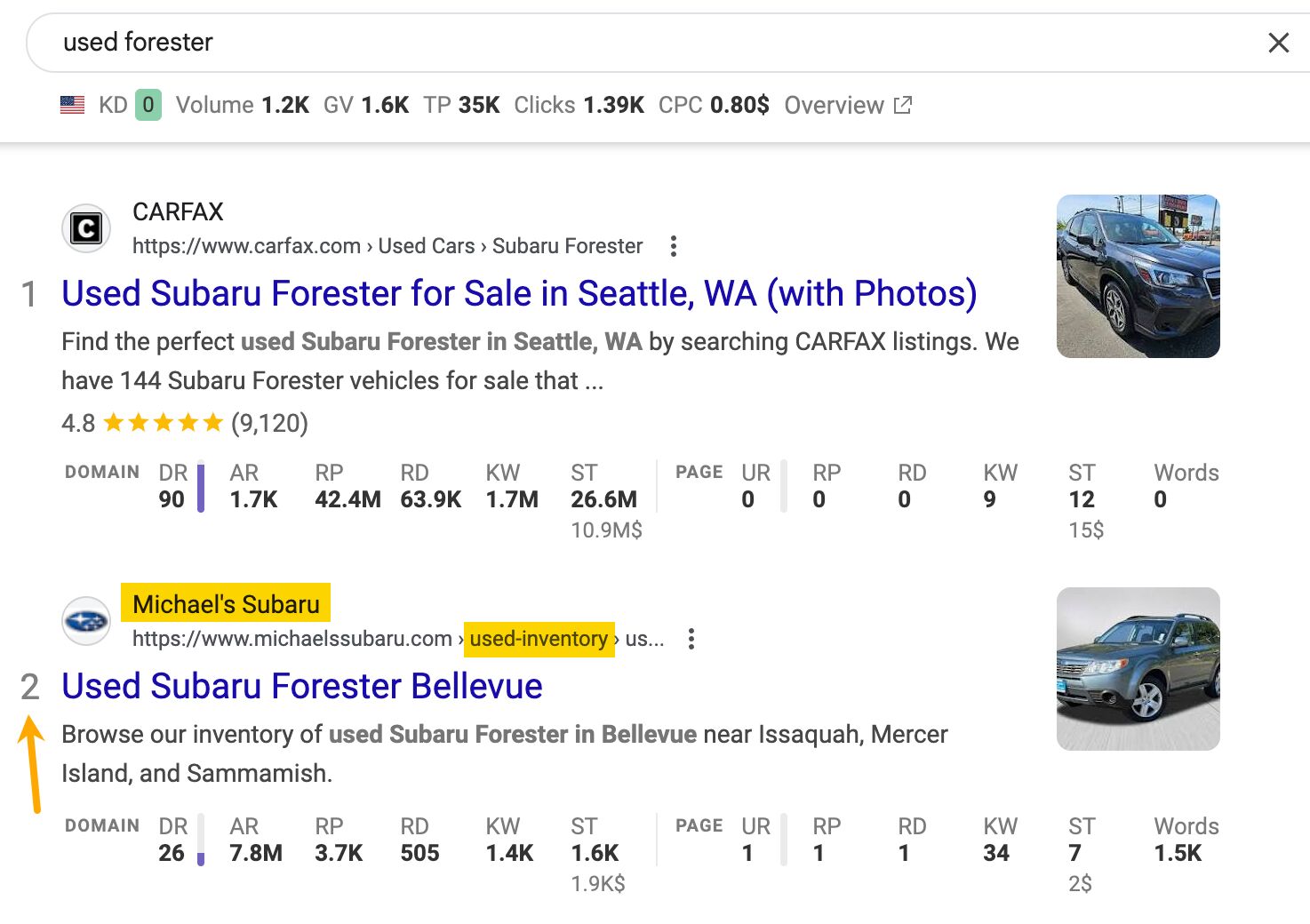
What to focus on:
- Use a clear category structure like “/inventory/suvs/mazda-cx5-2022/”
- Treat vehicle pages like product pages: include make, model, year, mileage, price, VIN, images, and conversion-focused CTAs.
- Use filters carefully (body type, price range, features) and prevent index bloat by canonicalizing non-useful URLs.
- Optimize image SEO by using descriptive filenames and alt text (this guide offers some good image SEO practices).
- Highlight key selling details like clean Carfax reports, full service history, and high-quality images.
Assess your vehicle data sources before scaling. Messy data (e.g., inconsistent naming, missing details) can wreak havoc when you go live. Test first with high-volume makes like Toyota or Ford. Categorization helps shoppers. Group cars into themes like “family friendly,” “first car,” “under $5k,” “off-road SUVs,” or “luxury SUVs.” These kinds of curated filters make for strong landing pages and better user experience.
If you’re using Google Business Profile (GBP), use the “Products and Services” section to feature brands and models you typically stock. Instead of trying to keep it updated daily, treat it like a curated highlight reel. Treat brand and model pages as permanent landing pages—even if you don’t have real-time inventory. Include CTAs like “Call us to check availability” or “These sell fast—get in touch now” to make them useful and evergreen.
Service pages
These bring in high-margin, high-frequency traffic—brake repair, inspections, tire rotation, etc. Most visitors come with a clear intent to act.
Below is an example of repair shops ranking with optimized location pages.
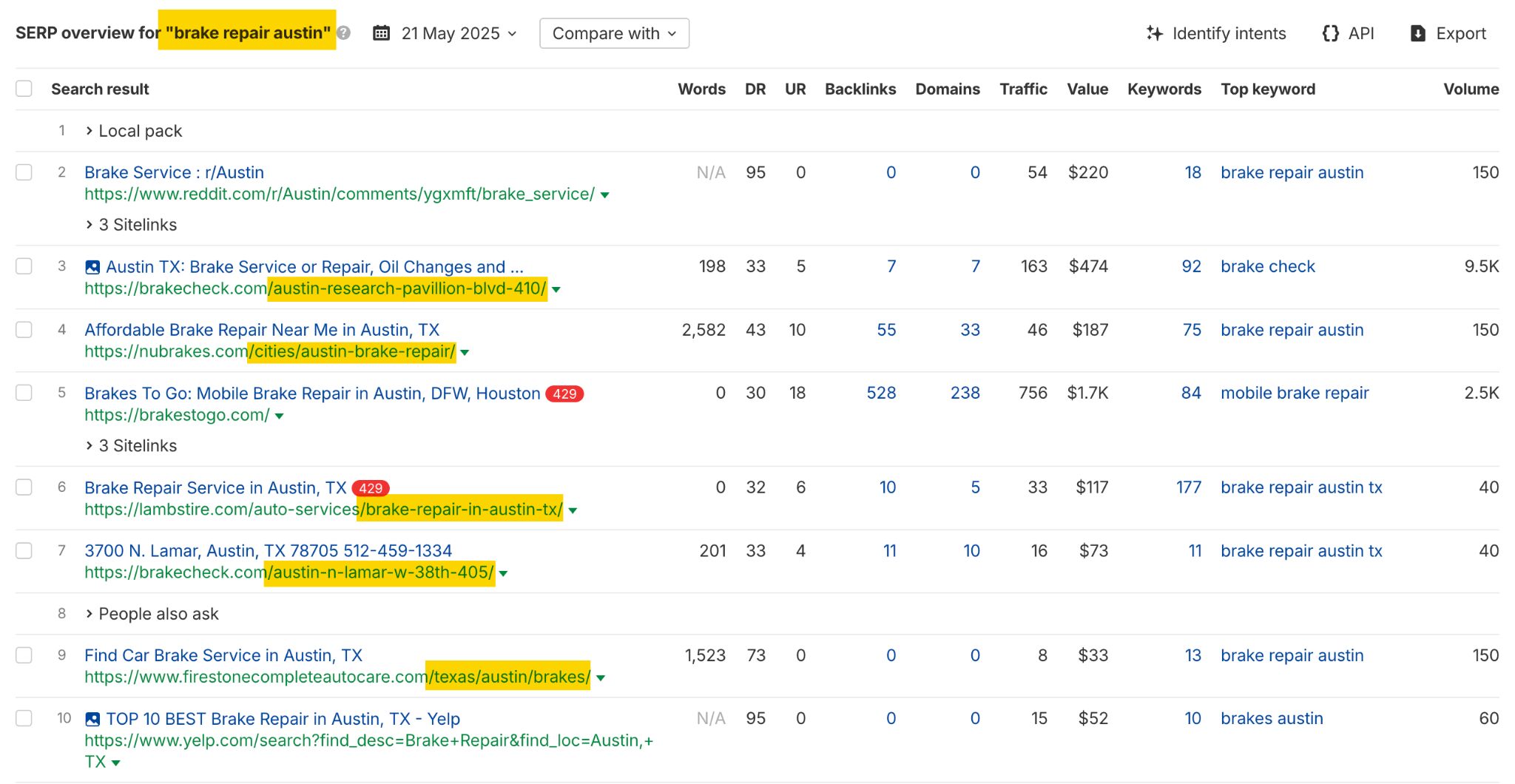
What to focus on:
- Create a dedicated page per service (e.g., “/services/brake-repair/”) and per location if relevant.
- Optimize for “service + city” queries like “oil change Austin”.
- Add trust signals: certifications, team bios, photos of your actual work, and pricing, if possible.
- Use FAQs, testimonials, and visual content to increase conversions.
Location pages
This is where local SEO and trust-building collide. Done right, these pages help you rank for “Toyota dealer [city]” and convert cold traffic into walk-ins or leads.
Here’s a great example by Sheen group: a landing page listing all locations and a dedicated landing page for each location.
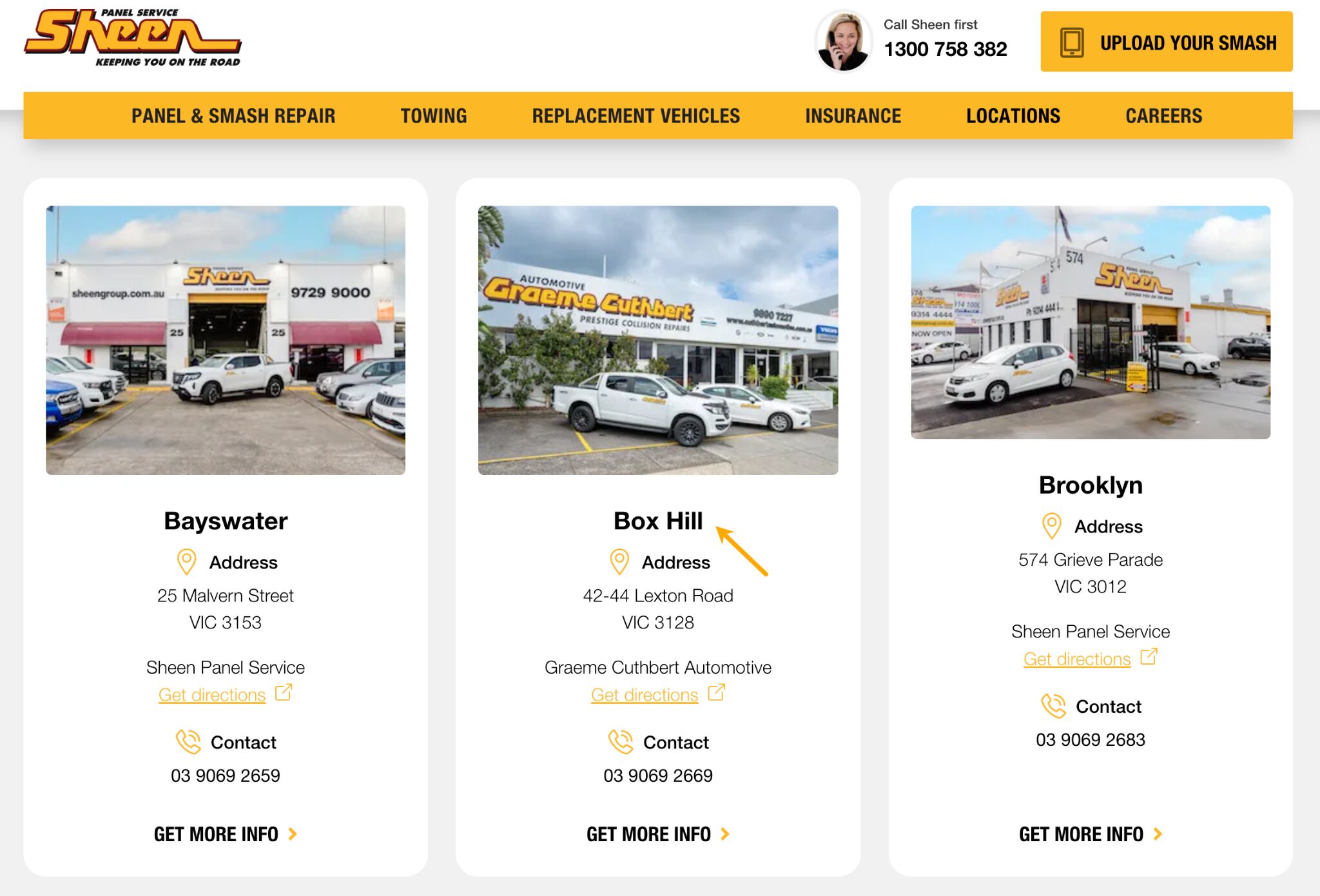
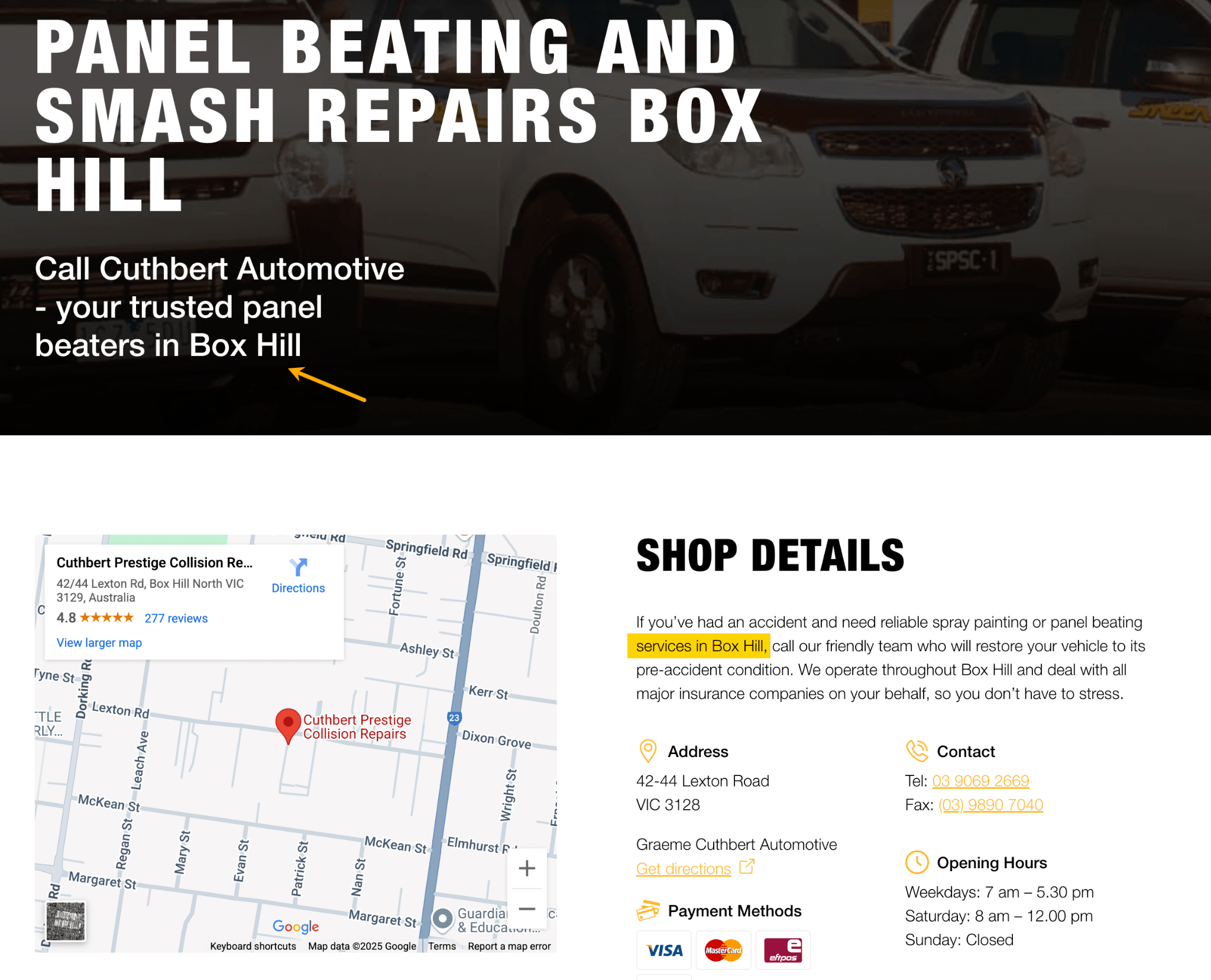
What to focus on:
- Use localized URLs and H1s: /locations/san-diego/ + “Used Cars in San Diego | Open 7 Days a Week”.
- Include real photos of the dealership, staff, and signage—avoid stock images.
- Add a map, driving directions, reviews, parking info, and hours.
- Link to the inventory and services available at that location.
- Display social proof: embedded reviews, certifications, and local awards.
This part of SEO is about making sure your website works the way it should—fast, easy to load, and simple for both people and Google to navigate.
I always give the same advice here: use a tool like Ahrefs’ Site Audit, fix the problems it finds, and keep it running regularly.
Ahrefs gives you an overall Health Score, showing how many pages on your site have serious issues—these are called errors. If you click on the error count, you’ll see exactly what the problems are, which pages are affected, and get tips on how to fix them.
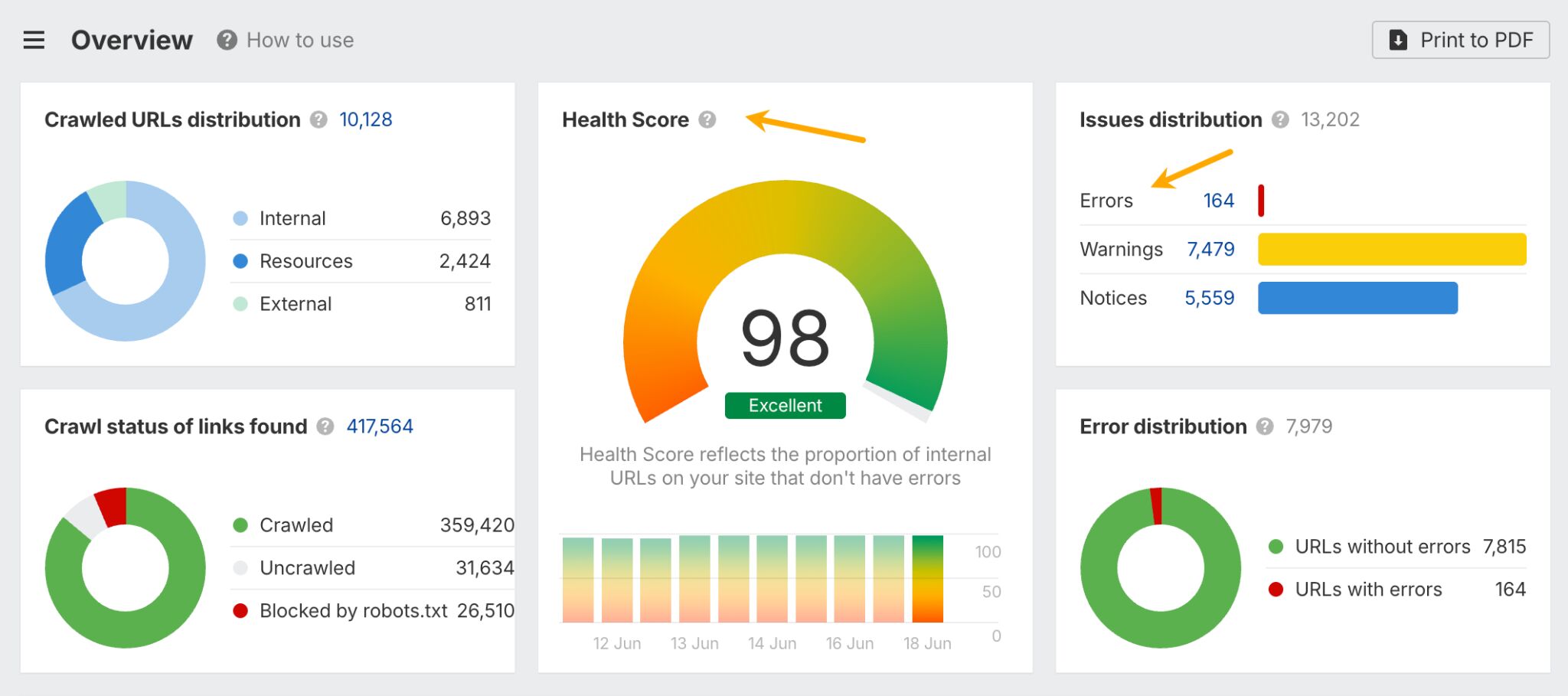
You don’t need to be a tech expert to handle most of these. Site audit tools will flag the most common issues that hurt your rankings, like:
- Broken pages. They return errors when people click on them.
- Slow page speed (especially on mobile).
- Missing page titles. Help Google and searchers understand your content.
- Duplicate pages. Google doesn’t like seeing the same content in multiple places.
- Pages that aren’t linked to. If nothing points to a page, Google might never find it.
- Mobile usability problems. If your site is hard to use on a phone, that’s a problem.
Once you fix what’s broken, this becomes a simple maintenance task. Site Audit performs regular checks on autopilot. Bigger sites with ecommerce inventory could benefit from an always-on audit that scans 24/7.
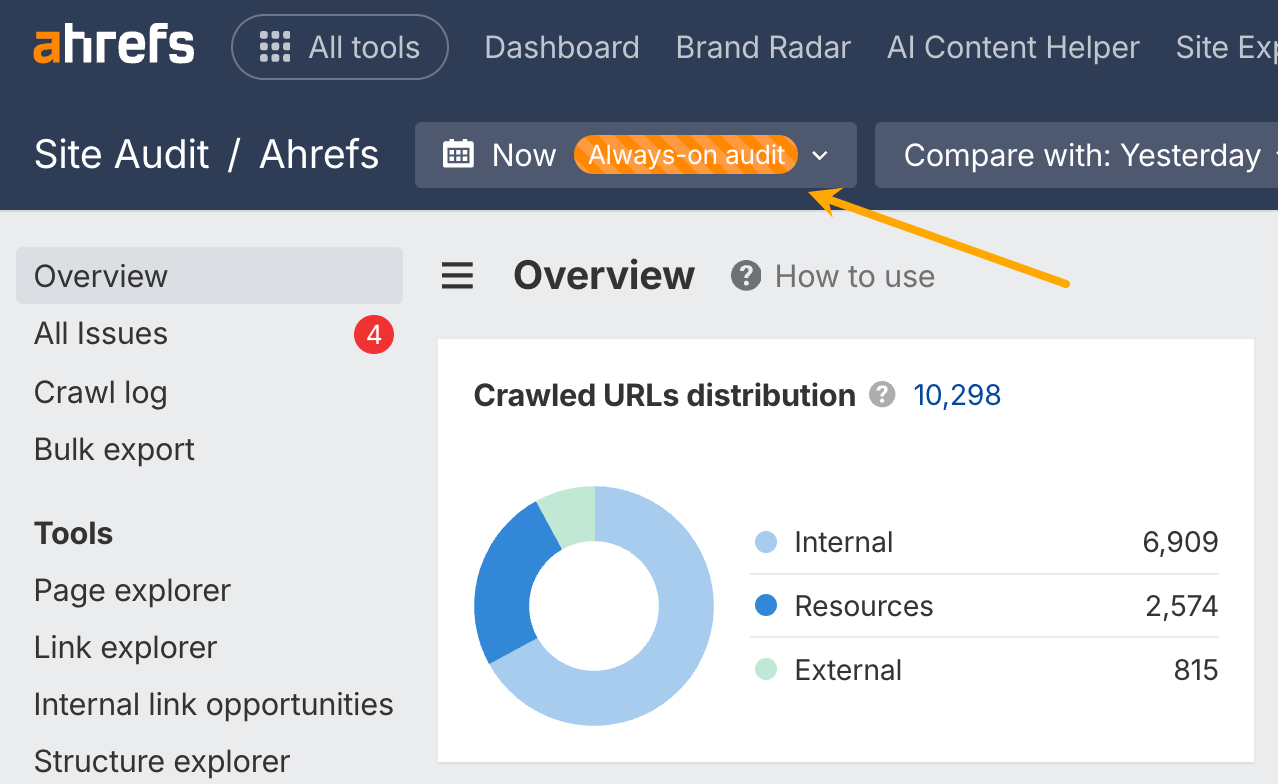
By the way, you’ll also get email alerts after each scan, so you don’t really need to remember to open the tool and check.

People head to YouTube when they want to see how something works, what a car looks like, or whether a mechanic knows their stuff. That’s a huge opportunity.
Video builds trust faster than text. A quick walkaround of a car, a before-and-after repair job, or a mechanic explaining a common problem can do more to convince a potential customer than a thousand words ever could.
And it doesn’t have to be fancy. A simple, honest video shot on your phone can work just fine, as long as it’s useful and answers real questions your customers have.
Plus, YouTube is the second biggest search engine in the world. If you’re not showing up there, you’re missing a ton of traffic from people actively researching, comparing, or getting ready to book.
And here’s the kicker: some people find your videos on YouTube, but many find them on Google. Google often pulls YouTube videos directly into its search results (right on the front page). That means a helpful video can give you visibility on two of the biggest search engines at once.

By the way, some AI search engines and LLMS like ChatGPT and Perplexity do the same:
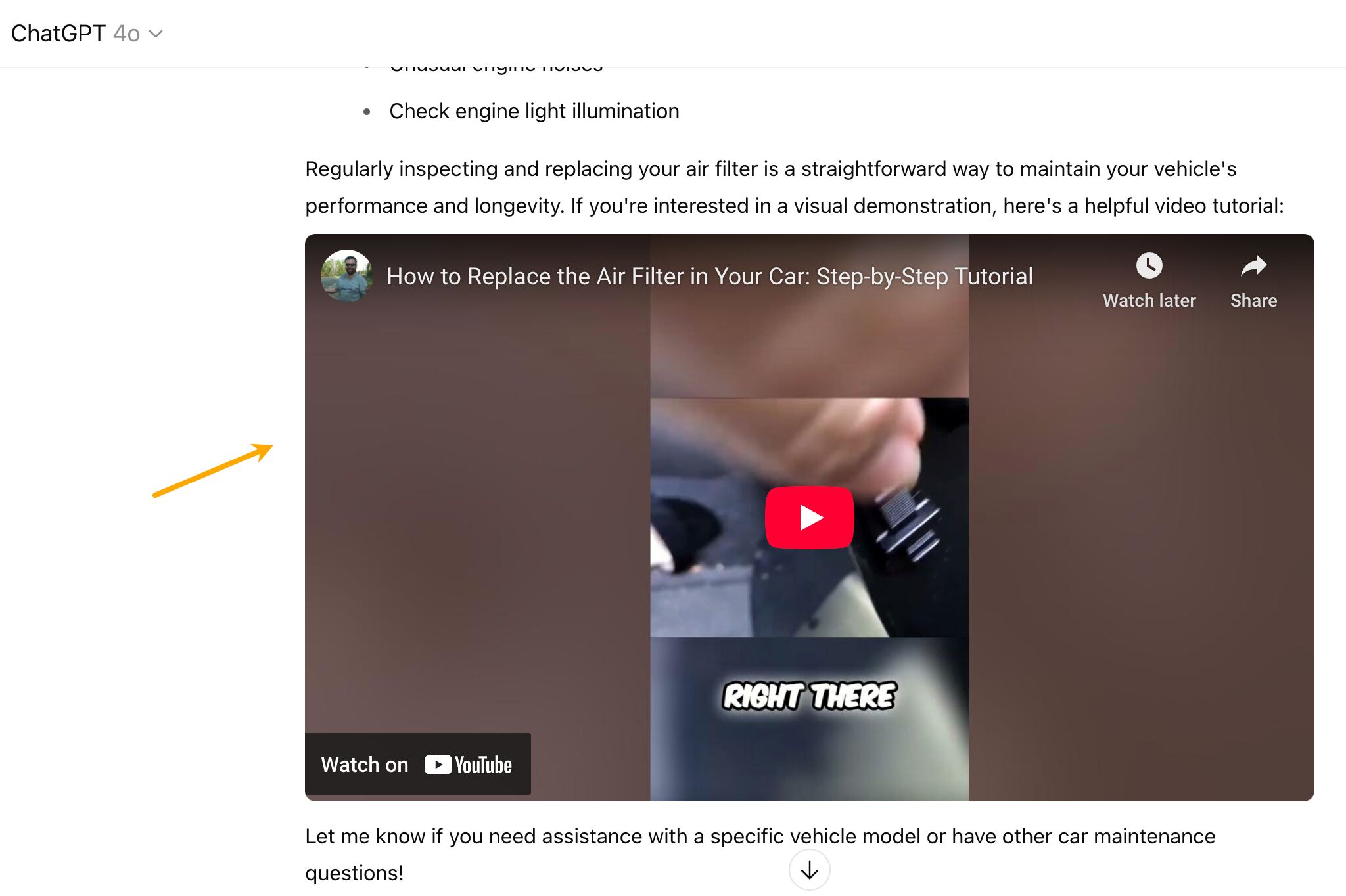
So, here are some ideas for videos you can make:
- Vehicle walkarounds. Give shoppers a closer look.
- Customer testimonials. Build trust authentically.
- Service & maintenance tips: Establish authority.
Review and vs content: Compare models (e.g., Kia Sportage vs Stonic). Share first-person insights on what’s better about a 2026 model vs 2025.
We’ve got an entire YouTube SEO course right here, so don’t miss it:
Before we wrap this section up, I wanted to show you how to find the aforementioned videos showing up on both Google and YouTube.
Head out to Ahrefs’ Keywords Explorer, paste in your seed keywords, and in the Matching terms report, turn on this SERP features filter:
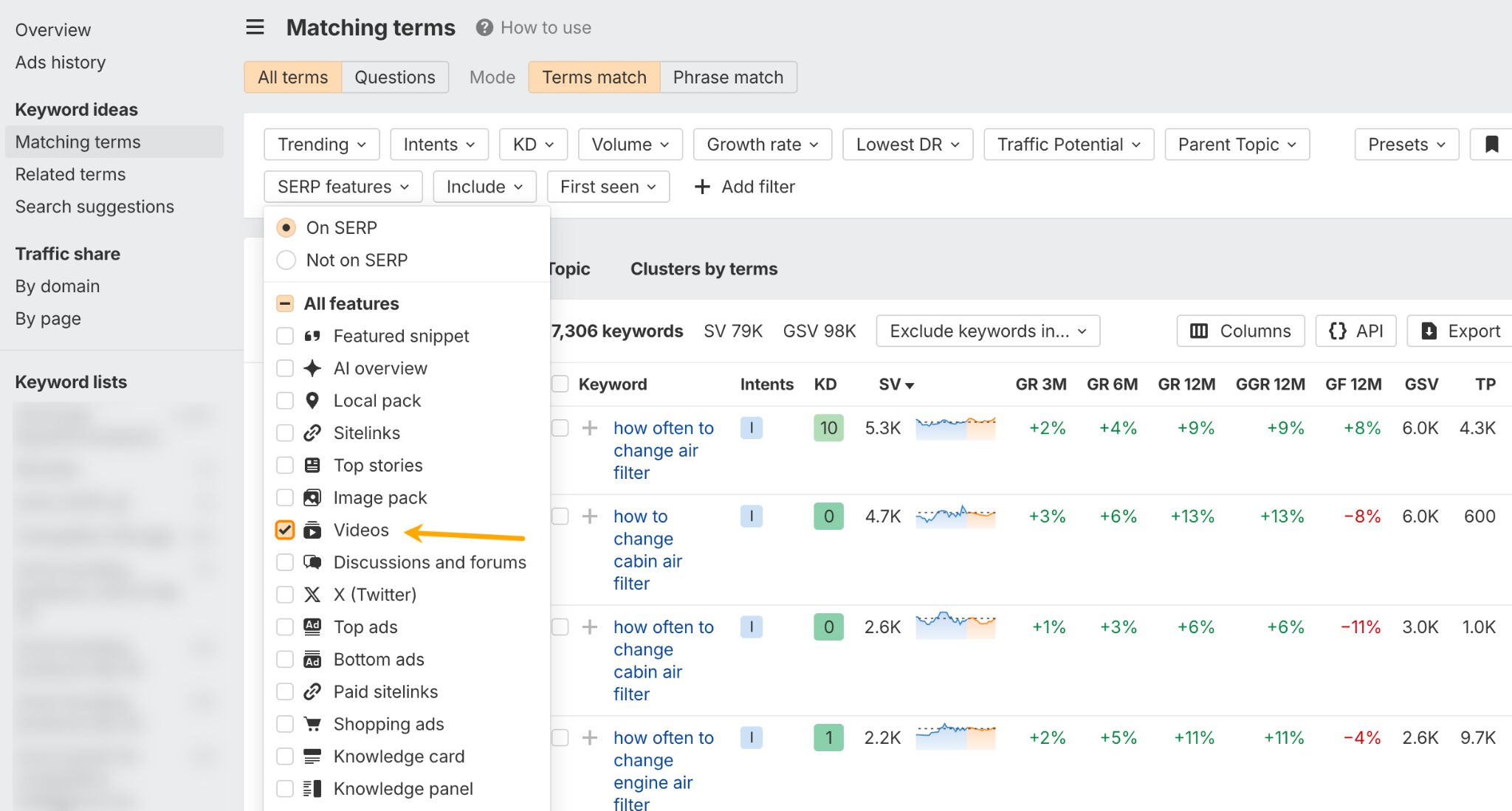
The results will be all keywords where Google shows videos in the SERPs, just like this one:
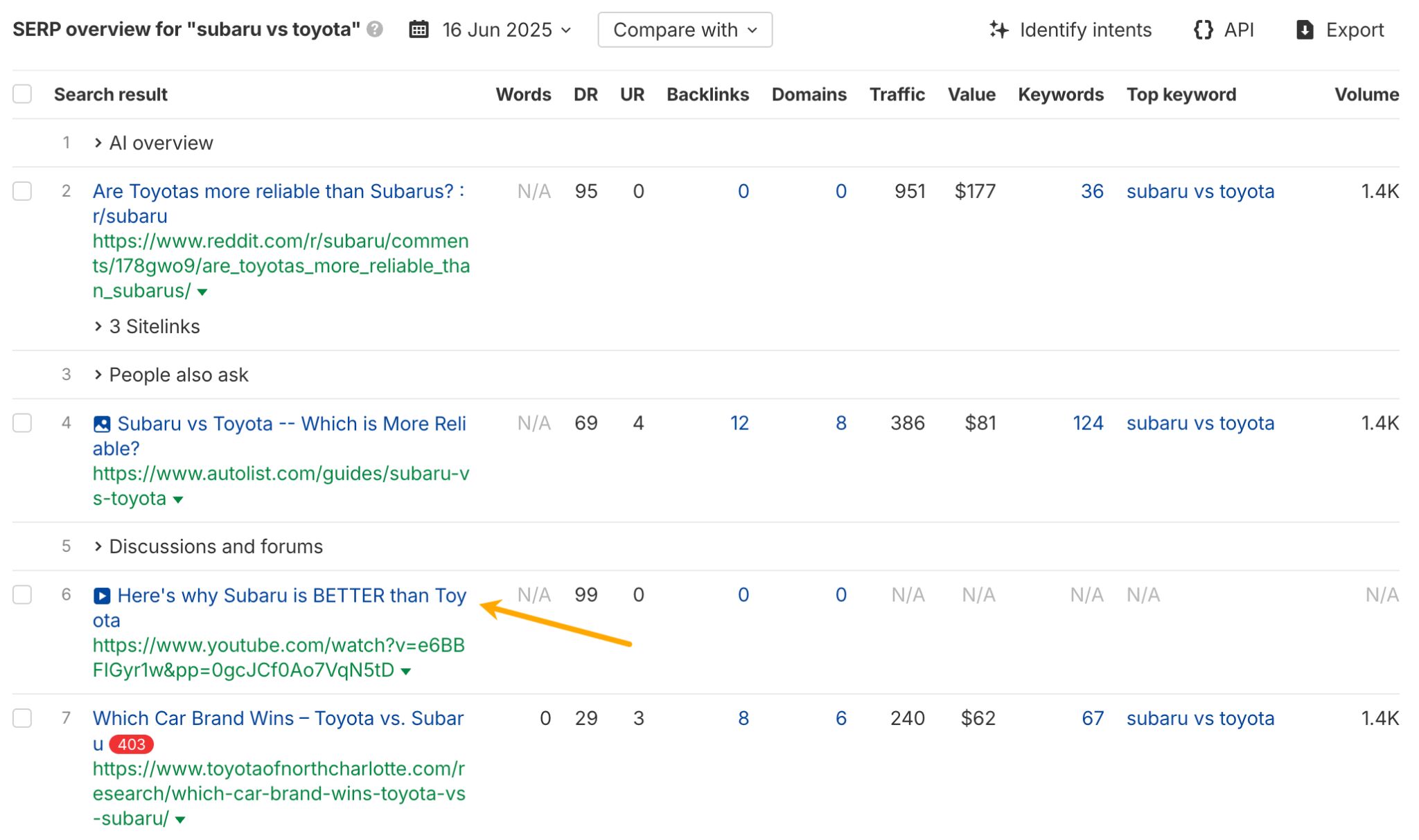
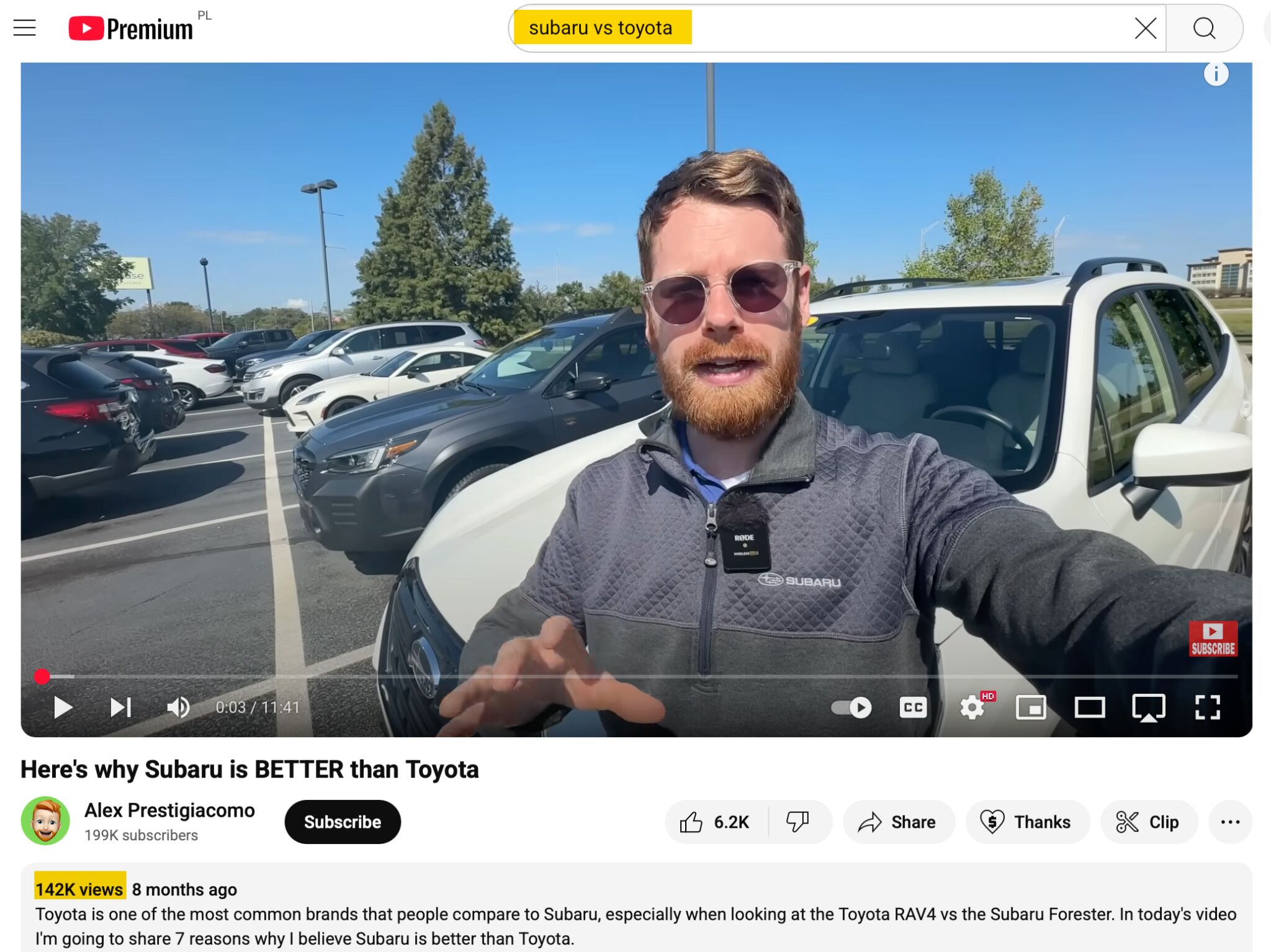
Finally, here’s a good tip from Michelle: don’t just post to YouTube. Include videos on blog pages or make/model pages to boost engagement and time on page.
Here’s something a lot of dealerships miss: SEO and Google Ads work better together than apart. Instead of seeing them as competing strategies, think of them as complementary approaches that can amplify each other.
Use ads to test keywords before committing to SEO. SEO takes months to show results, but you can test keyword performance with ads in days. If a keyword converts well in paid search, it’s probably worth targeting with SEO content too.
Cover all your bases. Use ads for competitive keywords where you’re not ranking yet, seasonal promotions, and new inventory that needs immediate visibility.
For this, I’d recommend setting up the following filter in Keywords Explorer: bottom of funnel preset, KD from 50 and the cost per click you feel comfortable with as the maximum.

Track these six key metrics to understand your SEO performance:
- Keyword rankings. Are you moving up for your target keywords?
- Share of voice. What percentage of traffic are you capturing compared to competitors for your tracked keywords?
- Organic traffic. How many visitors are coming from unpaid search results?
- Conversions. Are people actually filling out contact forms or booking service appointments? Track this by channel to see which efforts are paying off.
- Referring domain growth. How many quality websites are linking to you, and is that number growing?
- Technical SEO health. Are you staying on top of broken links, duplicate content, and site speed issues?
Keep an eye on competitors, too by monitoring their keyword rankings, tracking their content output, and setting up alerts for new rankings, backlink changes, and web mentions.
You can track all of the above using Ahrefs, and this guide will show you how to set it all up: SEO Tracking For Beginners: All You Need to Know. That includes form completions, custom events, and even funnels, all in the same tool.
And if you work for an agency, you can set up a report that updates on autopilot for each of your clients using Ahrefs’ Report Builder.
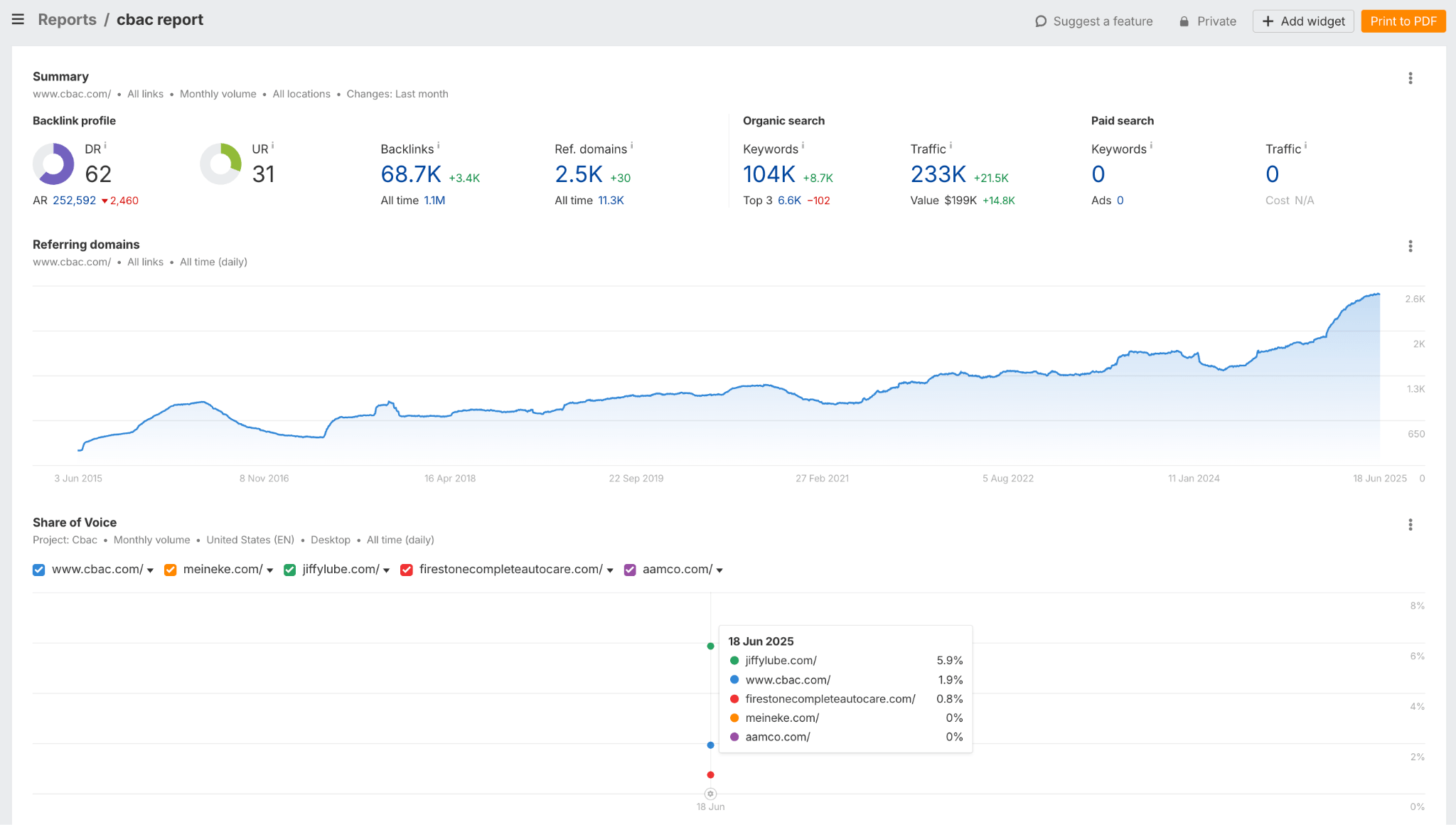
Final thoughts
My colleague Despina made me realize that ranking on Google is still important, but it’s not the only thing that matters anymore. People want real, honest opinions—from Reddit threads to TikTok videos (don’t miss our new TikTok SEO guide), forum discussions, YouTube reviews, and even AI tools like ChatGPT.
I’ve done it myself. It’s not that Google didn’t have answers—it had too many. So, I turned to ChatGPT and Gemini to help compare car sizes, safety ratings, reliability, warranty nitty gritty details and even wait time for spare parts on imported brands before I made the final decision.
The point is: real buying decisions are happening everywhere, not just on search engines. SEO is still the base, but if you want to stand out, your brand needs to show up wherever people are searching, scrolling, and asking for advice. In other words, your next move is “search everywhere optimization”.
Got questions or comments? Let me know on LinkedIn.






